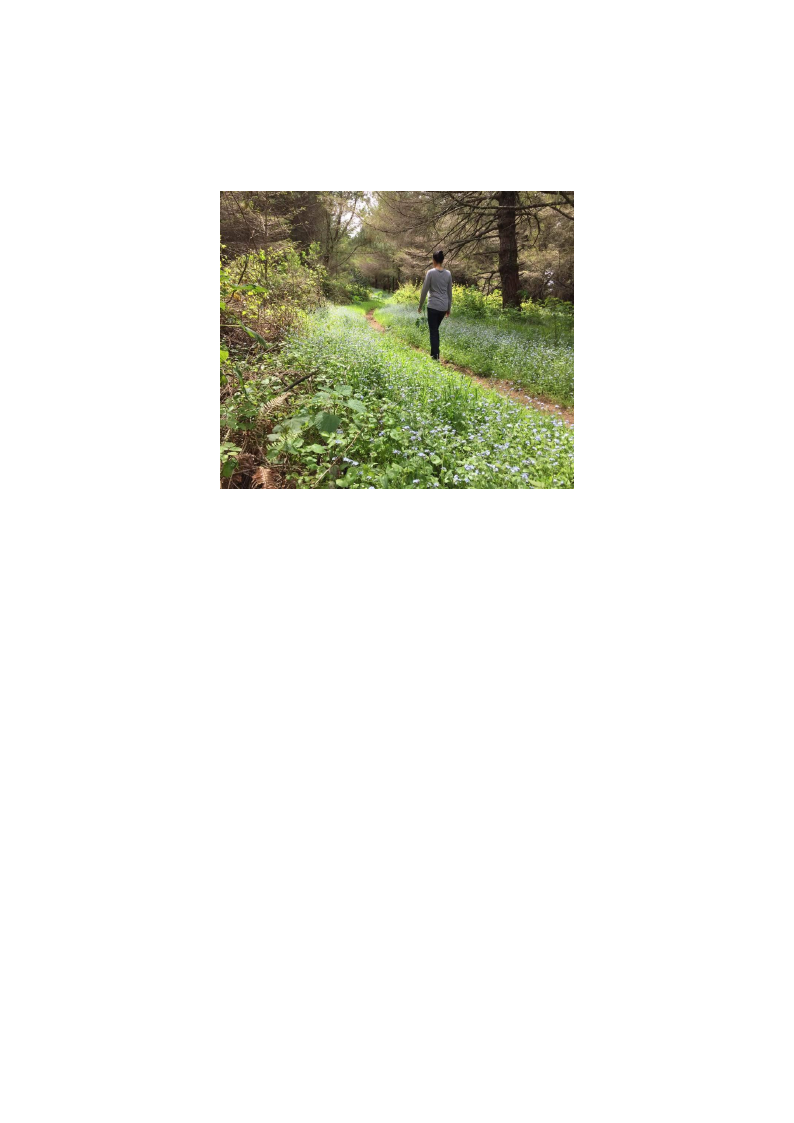
International Journal of
Environmental Research
and Public Health
Review
Shinrin-Yoku (Forest Bathing) and Nature Therapy:
A State-of-the-Art Review
Margaret M. Hansen *, Reo Jones and Kirsten Tocchini
School of Nursing and Health Professions, University of San Francisco, 2130 Fulton Street, San Francisco,
CA 94901, USA; rjjones2@usfca.edu (R.J.); kntocchini@usfca.edu (K.T.)
* Correspondence: mhansen@usfca.edu; Tel.: +1-014153787577
Academic Editors: Yoshifumi Miyazaki, Hiromitsu Kobayashi, Sin-Ae Park and Chorong Song
Received: 11 June 2017; Accepted: 21 July 2017; Published: 28 July 2017
Abstract: Background: Current literature supports the comprehensive health benefits of exposure
to nature and green environments on human systems. The aim of this state-of-the-art review is to
elucidate empirical research conducted on the physiological and psychological effects of Shinrin-Yoku
(or Forest Bathing) in transcontinental Japan and China. Furthermore, we aim to encourage healthcare
professionals to conduct longitudinal research in Western cultures regarding the clinically therapeutic
effects of Shinrin-Yoku and, for healthcare providers/students to consider practicing Shinrin-Yoku to
decrease undue stress and potential burnout. Methods: A thorough review was conducted to identify
research published with an initial open date range and then narrowing the collection to include
papers published from 2007 to 2017. Electronic databases (PubMed, PubMed Central, CINAHL,
PsycINFO and Scopus) and snowball references were used to cull papers that evaluated the use of
Shinrin-Yoku for various populations in diverse settings. Results: From the 127 papers initially culled
using the Boolean phrases: “Shinrin-yoku” AND/OR “forest bathing” AND/OR “nature therapy”,
64 studies met the inclusion criteria and were included in this summary review and then divided into
“physiological,” “psychological,” “sensory metrics” and “frameworks” sub-groups. Conclusions:
Human health benefits associated with the immersion in nature continue to be currently researched.
Longitudinal research, conducted worldwide, is needed to produce new evidence of the relationships
associated with Shinrin-Yoku and clinical therapeutic effects. Nature therapy as a health-promotion
method and potential universal health model is implicated for the reduction of reported modern-day
“stress-state” and “technostress.”.
Keywords: Shinrin-Yoku; forest bathing; nature therapy; integrative medicine
1. Introduction
Research conducted in transcontinental Japan and China points to a plethora of positive health
benefits for the human physiological and psychological systems associated with the practice of
Shinrin-Yoku (SY), also known as Forest Bathing FB (FB) [1–3]. SY is a traditional Japanese practice
of immersing oneself in nature by mindfully using all five senses. During the 1980s, SY surfaced
in Japan as a pivotal part of preventive health care and healing in Japanese medicine [4]. The
reported research findings associated with the healing components of SY specifically hones in on
the therapeutic effects on: (1) the immune system function (increase in natural killer cells/cancer
prevention); (2) cardiovascular system (hypertension/coronary artery disease); (3) the respiratory
system (allergies and respiratory disease); (4) depression and anxiety (mood disorders and stress);
(5) mental relaxation (Attention Deficit/Hyperactivity Disorder) and; (6) human feelings of “awe”
(increase in gratitude and selflessness) [5]. Moreover, various contemporary hypotheses, such as:
Kaplan’s Attention Restorative Hypothesis [6]; Ulrich’s Stress Reduction Hypothesis [7]; and Kellert
Int. J. Environ. Res. Public Health 2017, 14, 851; doi:10.3390/ijerph14080851
www.mdpi.com/journal/ijerph

Int. J. Environ. Res. Public Health 2017, 14, 851
Int. J. Environ. Res. Public Health 2017, 14, 851
2 of 48
2 of 37
and Wilson’s Biophilia Hypothesis [8] provide support and a lens for the practice of SY and other
forms of nature engagement.
Furthermore, SY may be considered a form of Nature Therapy (NT). Song, Ikei and Miyazaki’s
present day model: Conceepptt of Nature Therapyy (CNNTT)) [9] clearlyy deffiines NT as “a set of practices
aimed aattaacchhieievviningg‘p‘prervevenentitviveemmedeidciaclaelffeefcfetsc’tsth’ rtohuroguhgehxpeoxspuorseutroentaotunraatlusrtaiml sutliimthualit trhenatderernadsetartae
sotfaptehoyfsipohloygsicoalol greiclaxl aretiloanxaatniodnbaonodstbtohoestwtehaekweneeadkeinmemd uimnemfuunnectfiuonncstitonpsrteovepnretvdeinsetadsiesse”as[9es].”T[9h]e.
TcohnecceopntcueapltmuaoldmeloodfelNoTf NstTarsttsarwtsitwhiath“ast“rsetsrseesdsesdtasttea”tea”tatthtehetotpopananddththeennppooininttssttootthhee “restorative
effects” of nature (forests, flflowers, etc.) where there is a hypothesis of iimprovement in “physiological
relaxatioonn”” anandd“im“immumnuenfue nfcutinocntiroencovrecryo”vererysp”onresseps o(innsdeisvid(iunadlivdidffueraelncdeisffneoretendc)e.sThneoste dre).spTohnessees
rtoesnpaotnusrees atroe nthateunreinacroerpthoeranteidncionrpthoreatEevdidienntcheeBEavseiddenMcedBicaisneed(EMBeMdi)cimneod(EelBaMn)dmisodilelul satrnadteids
iblyluastnraatrerdowbyleaandainrrgowto ltehaedi“npgretvoetnhteiv“epmrevedenictaivl eefmfeecdt.i”caTlheifsfecclte.a”rTmhiosdcelleasrupmpoodretsl sSuopnpgo, rItkseSioanngd,
IMkeiyi aznadkMi’siy[a9z]arkeiv’sie[9w] roefviseowmoef smomedeicmaleldyicparlolyvpenroovuentcooumtceos.meKs.aKpalapnlaannadndKKapaplalnan[[66]] associated
with exppoossuurree ttoonnaatuturraallylyooccucurrirninggstsitmimuluil(ia(lal l5l s5ensesnes)est)hatht ahtashasdairedcitreecftfeecftfeocnt ionncrienacsrienagsitnhge
pthaerapsayrmaspyamthpeatitchenteicrvnoeurvsosuysstseymsteamndanadhaeihgehigtehntedneadwaawreanrenssestshtahtaltelaedasdstotoaassttaattee ooff relaxation
(Figure 1).
FFiigguurree 11.. CCoonncceepptt ooff nnaattuurree tthheerraappyy [[99]].. PPeerrmmiissssiioonn ttoo ppuubblliisshh ffrroomm YYoosshhiiffuummii MMiiyyaassaakkii..
wwpyspsoats2JiCfbPashFoaiCShansharptptrrn5nwveveTeuhoheoyrueipeei0seenaaddedeesyynmscmrridoah0acrriirresiseuhesstlttnsnipaalakeosafusSIISliiisiflrsyuiolncnvlnreets-uisniwaeeportclilhncGaeiayxslmdsendttyvvgsmoanrhhoatahseengnacsdeeieieoenoneilbgeeirvShv,hedmicwlrarnsrsipfftst”anaeyiCwtivamaioo.fhrdtcadloGlihhdawiehulol[aihtlwatnByrtnaidtocu5auhyhuoisldgosrpilegiryinent]nnngtuseansmdaswuoauaseaaa.udwxgi-ailcetualgrenncsningpGcsTouidsaertxnttlssitewadatidhdseohtfnahrdwihpinepsltlilhlenraei,,niyynFhksacerriporviasvidehwsehghmootnns”sTeatenesbstiehisaaueieiaapuGadntexcednychfsecanx[teovvihfrsddaihrgegciii5gortnepne1dn.naneeheemvduihhue]Srat5vglxanp.asguaweaBpeeomoomemmids-ispeinn,rnaTtnpmowlnmryhgeieeaelanoPlaaooidenddihcyurdexhyonpllniagdnanirreaechkiudetplrsntverventtiiihrssbsrhseseuiasunuecnthoMeaasicsieuoohdiadiibandsmhntcisritealincnnfftpeoseiiealieehedeuaseaiidlntg1iratanranntdpvdateturllotvaotha5watnrstohsnd,dhepiisuinsllehrcos-euctfn[itnsuelePemeeesotefg3iityphuGslerinvetSiyn[aseipcave]hhnc,ai2neorsnirhen.necosbsSvrraenattbpdasg]elgsehaoelaepu.dhsred.ip,ylnapeigeStctusoatilodieioAihuiaupnhccnyhesaorpnlSnlklnlrffetnleeoeilrtriantagYrnaoMpsmnikvemsaletaagvoegcgpguurtoinaanennawlnifchrbmeeorreeetewbscsfrsrleioedehdaeereatuih,eaa[ipksueglsoerdwet3:tnc/n:ealn,dtGneahaorwCnpntg]tdinadi“twibae:enes.rcpnwSenphrredacueTdfircanssteoSsoo.aenghgetscecslrpnhpietteaumoabllfyoaSfhttfnirsssilnnaieatuneuhrrnoelcYta-l,npeeuootceeslacrbphglnlngraghrneaecrfedfitneaepapshorerfiiaeae/esrstsSscon:nietarwfualuhkger“ratneioYtsrh“nad(oo(edsstrfrueriageetGoGgTsdcoibadpfpeiEehgriedalisnafiisrarnhulSncanSohopercnesr-eeua“gche)noe)racssvsbengawvAslocts[icaeeeehfldaeernstrruini9aavlrtrfsinreeeeleislioitt]orttfglsmiainoencnbatrppshSmheetnaftwisoasodgndetscYhoegnotnilgcolagfgnf”htnimtieerbdrtureaiffsfsucnaoemscmnettae“eetsi,elaoecheofiiponeeaindcindbbn[ra[tnoiuogaresm“rftay1dn1ieioteeeausnstannonnflh0aa0ufvi,wis[omo(etlsifnnstniAgb]9ec]FeiurteHofircstcrn.t.ndcsg]sugbar”iTsereosmr[mCceifCagereat5hassirdodfg)ratsimmatciuaoedyt”t]nunoohgafneenneche.nlb[rrtmdrddaenotmoopa2citudhersHcrrhtattimetr,rerreheairaeredts3tho,eecoornsnhbih-aenylrpiub,seeoennagn9gt.aasdtaeosvteeutmischduns,onpprttnoTshwunhnas1rpstuaeaendcnfiaercye[urhs1yeeecrfclommi5ritiancaci]treormamecaeemrF(hs]coi.itusggcnFilam.finpo,iobeaia1eteafPitoaleeealTtnndthcntinriads6dnlinHhttdtilyvPlaayf)osrnfiitidatedbyi”.eecicilhhetsdtilbcancraln[sr,,rsestrTyJSoepae2eotfracpnrfiCtasfiniiuardcfoawh,cioccertfnniaecp3ofnennieeroiarihlsurheePonea,ndomfieaeddnddsi9ggcrgncemkncexga2,ne1totit,irtoaoaaarc1itisntnuss5nin6iettanenahsrnnclooeloe1hh0ggrttstomolootilaiigsddddd]hhnyyya0eeeecsss-ftfll.,,
Chiba University, Japan, researchers measured oxyhemoglobin levels in the pre-frontal cortexes of
research participants while the participants observed three dracaena plants [11]. Results indicated a

Int. J. Environ. Res. Public Health 2017, 14, 851
3 of 48
and depression [2]. At the Center for Environment, Health, and Field Sciences, Chiba University,
Japan, researchers measured oxyhemoglobin levels in the pre-frontal cortexes of research participants
while the participants observed three dracaena plants [11]. Results indicated a significant increase in
participants’ oxyhemoglobin levels for urban, domestic and workplace foliage effects which directly
demonstrates the health-promotion effects associated with indoor foliage plants on humans [11].
While exploring recent research about the health benefits associated with SY a dearth of scientific
research conducted in Western populations was determined. Therefore, the increasing interest and the
current published significant research findings surrounding the healing benefits related to SY, GS and
the wilderness offers healthcare professionals an opportunity to delve deeper into this complementary
modality for the prevention of disease and to assist with the potential healing of certain existing
conditions in Western cultures. Revealing current research methods and subsequent research outcomes
associated with SY practices may provide researchers, clinicians and students with an intervention that
assists with preventative medicine and evidence-based practice (EBP). Therefore, the aim of this paper
is to offer: (a) an in-depth inquiry of the current literature, (b) invite researchers residing in Western
cultures to design and conduct empirical research regarding the therapeutic benefits associated with
SY and, (c) to encourage healthcare providers/students to consider practicing SY to decrease undue
stress and potential disconnection.
2. Materials and Methods
Review Method
The terms of this comprehensive review were to emphasize the core elements of the research
proposition. The initial literature search was conducted with the intention of identifying publications
that offered significant historic relevance to the practice of SY, included various populations, sample
sizes and geographic locales, utilized evidence-based practices, illustrated measurable physiological
and psychological effect parameters, expounded upon practical frameworks and methodologies for the
practice of SY, explicated unique measurable criteria for the application of SY and deduced limitations
of previous research.
Search Method
The electronic databases searched included PubMed Central, PubMed, CINAHL, Scopus, and
PsycINFO (Figure 2). Hand searched bibliographies and reference lists from seminal researchers of
SY were also applied to the initial culling of publications. PubMed Central was searched to ensure
the incorporation of relevant publications not indexed in PubMed. Keywords were used for each
database and during snowball searches. All titles and abstracts were searched with the following
terms: “shinrin-yoku,” “forest bathing,” and “nature therapy.” These searches were combined with the
Boolean operators AND/OR. These terms were chosen from careful analyses of supporting literature.
For example, the aforementioned terms “nature therapy”, “shinrin-yoku”, and “forest therapy” are
used in conjunction with one another in the most recent scholarly literature review of NT in Japan [9].
To remain prescient, the reference range utilized in this review included literature published
between the years 2007 and 2017. Therefore, the inclusion criteria allowed for publications that were
available in English, dated from 2007 to 2017, incorporated transparent evidence based practices in
reviews or trials, included robust quantitative and/or qualitative data, offered unique frameworks
and theories, and explored current trends in research. Studies not meeting the tenets of this criteria,
specifically those that pertained to physical exercise, fitness, landscape architecture, and laboratory, or
animal studies were withdrawn from considerations.

IInntt.. JJ.. EEnnvviirroonn.. RReess.. PPuubblliicc HHeeaalltthh 22001177,, 1144,, 885511
44 ooff 4387
FFiigguurree 22.. LLiitteerraattuurree sseeaarrcchh pprroocceessss..
3. Results
The fifindings of aallll rreelleevvaanntt ssttuuddiieess wweerree ssyynntthheessiizzeedd ((TTaabbllee 11)).. The initial literature search
revealed a series of topical themes apropos of the research aim. Articles were grouped into categories
reflflecting upon their mmoosstt ppeerrttiinneenntt ffeeaattuurreess.. Thessee categoriess include Background information,
Frameworks, Physiologgiiccaall andd Psychhoollooggiiccaall eeffffeeccttss,, SSeennssoorryy MMeettrriiccss,, aanndd LLiimmiittaattiioonnss ttoo ffiinnddiinnggss..
Previous Systematic Reviews and Literature Reviews were identifified. Characteristics of publications
specifificc ttoo tthhee tthheemmeessooffPPhhyyssiioollooggiiccaallaannddPPssyycchhoolologgiciacal lEEfffefcetcsts(P(PP),)S, eSnesnosroyryMMetertircisc(sS(MSM), )w, whihchichisias
sausbutbotpoipciocfoPfPP,Pa,nadnFdrFamraemweowrkosrk(sF)(Fa)reardeedlienleinateeadte, dan, aenxpexlipcalitceadtewdiwthiitnhitnhethkeeykeiyn iTnabTlaeb1le. 1.
3.1. Physiological and Psychological (PP) Effects
Livni [12] published an editorial on the health benefits of SY and described the historic trends in
biophysical and psychosocial research. While news of the beneficial elements of SY has been
gathering momentum in popular lexicon, it has been the robustness of pioneering research, largely
from Japanese scholars, that illuminates empirical links between the PP effects of SY. Tsunetsugu,
Park and Miyazaki [13] conducted a novel review representing a didactic integration of various
parameters specific to central nervous system (CNS) activity biomarkers; heart-rate variability
(HRV), salivary cortisol levels (SCL), immunoglobulin A (IgA) and sense-specific metrics.
Of the studies included within the PP section, and irrespective of study aims, there was a trend
towards small sample sizes, gender and age homogeneity, and skewed ratios of females to males/vice
versa, which by either methods of convenience, purpose and/or imparted bias to the research. An
overwhelming number of studies included homogenous gender sampling [14–27]. Population
demographics specific to gender were unreported in [28–30]. Proportionately skewed ratios of male

Int. J. Environ. Res. Public Health 2017, 14, 851
5 of 48
Study
Bowler [1]
Chun [2]
Table 1. Characteristics of selected studies and supporting evidence.
Country
UK
Korea
Population
Articles were culled from
PubMed, EMBASE, CINAHL,
PsycINFO, Web of Science,
SPORTDiscus, ASSIA, HMIC
Data, LILACS, UK Natl.
Research Register archives,
TRIP database, UK Natl. Lib.
for Health, Index to Theses
Online, Directory of Open
Access Journals, Economic and
Social Data Service, Database
of Promoting Health
Effectiveness Reviews, Trials
Register of Promoting Health
Interventions, Cochrane
Collab., Campbell Collab.
Sample
Article total = 25. Studies that
met the review inclusion
criteria included crossover or
controlled trials, which
investigated the effects of
short-term exposure to each
environment during a walk or
run. Including ‘natural’
environments, such as public
parks and green university
campuses, and synthetic
environments, such as indoor
and outdoor built
environments.
Chronic stroke patients
recruited from a stroke welfare
center in the Republic of Korea.
Of those included: 31 patients
had a history of cerebral
infarcts, and 28 with a history
of intracerebral hemorrhage.
N = 59; 40 men, 19 women; 60.8
± 9.1 years of age with an age
range of 36–79 years.
Setting
Centre for Evidence-Based
Conservation at the School of
the Environment and Natural
Resources, Bangor University,
Bangor, Gwynedd, United
Kingdom.
Settings included a recreational
forest area in Gyenggi-do,
Republic of Korea. The urban
group stayed in a hotel
Gyenggi-do in the Republic of
Korea.
Aim & Design
Systematic review to collate
and synthesize the findings of
studies that compare
measurements of health or
well-being in natural and
synthetic environments. Effect
sizes of the differences between
environments were calculated
and meta-analysis used to
synthesize data from studies
measuring similar outcomes.
PP
Assessment of forest therapy
effectiveness for treating
depression and anxiety in
patients with chronic stroke by
using psychological tests. This
study measured reactive
oxygen metabolite (d-ROM)
levels and biological
antioxidant (BAPs) potentials
associated with psychological
stress. Patients were randomly
assigned to a forest group
(recreational forest site) or
urban group (staying in an
urban hotel). Scores on Beck’s
Depression Inventory,
Hamilton Depression Scale,
and the Spielberger State Trait
Anxiety Inventory were
analyzed.
PP
Findings
The studies suggested that
natural environments may
have direct and positive
impacts on several aspects of
health and well-being.
Forest groups had BDI,
HAm-D17 and STAI scores
were significantly lower
following treatment. BAPs
were significantly higher than
baseline. Urban group STI
scores were significantly higher
following treatment. Forest
therapy is beneficial for
treating depression and anxiety
symptoms in patients with
chronic stroke and may be
useful in patients who can’t be
treated by standard
pharmacological or
electroconvulsive therapies.

Int. J. Environ. Res. Public Health 2017, 14, 851
6 of 48
Table 1. Cont.
Study
Han [3]
Anonymous
[4]
Williams [5]
Kaplan [6]
Ulrich [7]
Kellert [8]
Song [9]
Country
Korea
Japan
Population
Sample
Employees of a public
organization providing
building and facilities
management services in Seoul
Metro area, all of whom were
diagnosed with Chronic
Widespread Pain (CWP).
N = 61; 35 females and 26
males; randomly assigned to
the either the experimental
forest therapy group (n = 33),
or the control group (n = 28).
Supporting material
NA
Supporting material
NA
Supporting material
NA
Supporting material
NA
Supporting material
NA
Researchers culled articles
from the Pubmed database
using various keywords.
Article total: 52
Setting
Forest therapy intervention
took place at a campsite at the
Saneum Natural Recreation
Forest in Yangpyeong county
of Gyeonggi Province.
Additional assessments were
taken at the Inje University
Seoul Paik Hospital in the
urban environment.
NA
NA
NA
NA
NA
NA
Aim & Design
To explore the effects of a 2-day
forest therapy program on
those with chronic widespread
pain.
Measures assessed included
the following: pre- post heart
rate variability, natural killer
cell, self-reported pain,
depression level and health
related quality of life.
PP
Shinrin Yoku. A website
describing the practice of SY
and programs offered for forest
guide training.
An article presented in the
National Geographic magazine
about the effects of NT.
A book about Kaplan’s
Attention Restorative
Hypothesis.
An article about Ulrich’s Stress
Reduction Hypothesis.
A book explaining the
Biophilia Hypothesis.
Literature review aimed to
objectively demonstrate the
physiological effects of NT.
Reviewed research findings in
Japan related to the green
space, plants and wooden
material and the analysis of
differences that arise therein.
PP
Findings
Forest therapy participants
reported significant decreases
in pain, depression and
increased QOL. Forest therapy
is an effective intervention to
relieve psychological and
physiological pain.
NA
NA
NA
NA
NA
Researchers elucidated various
scientific data, which assessed
physiological indicators, such
as brain activity, autonomic
nervous activity, endocrine
activity, immune activity are
accumulating from the field
and lab experiments. NT will
play a significant role in
preventative medicine in
the future.

Int. J. Environ. Res. Public Health 2017, 14, 851
7 of 48
Table 1. Cont.
Study
Sifferlin [10]
Igarashi [11]
Livni [12]
Country
Japan
Population
Supporting material
Female students from the
University of Chiba, Japan,
deemed healthy at the time of
the study.
Supporting material
Sample
NA
Setting
NA
N = 18; adult female university
students with a mean age of
21.6 ± 1.5 years.
Artificial climate chamber in a
laboratory of the Center for
Environment, Health, and
Field Sciences, Chiba
University, Japan.
NA
NA
Aim & Design
Findings
A Time magazine article about
the effects of living and
interacting in green spaces.
Results indicate people are
more energetic, in good overall
NA
health and have more of a
sense of meaningful purpose
in life.
Quantitative study was to
determine if images of natural
objects elicited similar neural
responses (activation of the
prefrontal cortex) as those
brought about with the
interaction of real objects.
Physiological measurements
were performed in an artificial
climate chamber maintained at
25 ◦C with 50% relative
humidity and 300 lux
illumination. For foliage plants
three dracaena plants (Dracaena
deremensis) were used.
Oxy-hemoglobin
concentrations in the prefrontal
cortex were assessed with
time-resolved near-infrared
spectroscopy.
SM
Subjects viewing actual live
plants had significantly
increased oxy-hemoglobin
concentrations in the prefrontal
cortex. Subjective ratings of
“comfortable vs.
uncomfortable” and “relaxed
vs. awakening” were similar
for both live and artificial
plants. Results were significant
for the benefits for urban,
domestic and
workplace foliage.
The Japanese practice of ‘Forest
Bathing’ as scientifically
NA
proven to improve your health.

Int. J. Environ. Res. Public Health 2017, 14, 851
8 of 48
Table 1. Cont.
Study
Tsunetsugu
[13]
Jo [14]
Country
Population
Japan
N/A
Japan
Participants comprised
Japanese male graduate and
undergraduate students at
Chiba University, recruited
from landscape and
horticulture programs.
Sample
Author-researchers culled
articles for this literature
review from a studies rooted in
physiological data, data
collected from field
experiments in forest settings,
laboratory settings, and studies
categorized into sub-themes
specific to the five-senses.
Exact literature search
methodology and total number
of articles culled unknown.
N = 26; males aged early to
mid- twenties mean age 24 ±
1.8 years.
Setting
N/A
Chiba University in a screened
room, such that the
participants were blinded to
the observers.
Aim & Design
To investigate the physiological
effects of Shinrin-yoku
according to specific themes
centered on the health
applications of FB. The authors
reviewed previous
physiological experiments with
trials in forests and laboratory
settings, to determine the
physiological effects on
individuals from exposure to
forests and elements of forest
settings. Metrics investigated
included: physiological
measurements of central
nervous activity, autonomic
nervous activity, and
biomarkers reflecting stress
response.
PP
Quantitative. Controlled trial
without randomization. The
aim of this study was to
elucidate how floral fragrance
could impact human health;
specifically, the
psycho-physiological
responses to the floral scent of
the Japanese plum blossom.
Changes in cerebral activity
were measured by
multichannel near-infrared
spectroscopy. Pulse rate,
heart-rate variability and
arterial blood pressure were
taken. The brief-form Japanese
version Profile of Mood States
questionnaire (POMS) tested
for psychological stress.
SM
Findings
Author-researchers
summarized the separate
elements of forests in terms of
the five senses, and provide
contribution to effects of
Shinrin-yoku within the
framework of the “Therapeutic
Effects of Forests” project.
Sensory stimuli from plants
may reduce stress and provide
a general sense of wellbeing
among this population.
Hypothesis was supported by
the data.

Int. J. Environ. Res. Public Health 2017, 14, 851
9 of 48
Table 1. Cont.
Study
Igarashi [15]
Ikei [16]
Country
Japan
Japan
Population
Sample
Setting
Seventeen Japanese adult
females were recruited from a
population living within the
urban suburbs of Kashiwa in
the Chiba Prefecture of Japan.
All were deemed healthy prior
to the experiment.
N = 17; Adult Japanese females
with a mean age of 46.1 ± 8.2
years.
Kiwifruit orchard adjacent to
the Center for Environment,
Health and Field Sciences,
Chiba University, Japan.
Female students from the
University of Chiba, Japan,
deemed healthy at the time of
the study.
N = 13; adult female university Center for Environment,
students with a mean age of
Health and Field Sciences,
21.5 ± 1.0 years.
Chiba University, Japan.
Aim & Design
Physiological and
psychological relaxation effects
of viewing kiwifruit orchard
landscapes in summertime in
Japan were investigated.
Quantitative, randomized
controlled trial wherein
subjects viewed a kiwifruit
orchard landscape or a
building site (control) for 10
min. Intervals. HRV and HR
were measured continuously.
Modified semantic differential
method and short-form Profile
of Mood States (POMS) were
determined.
SM
Quantitative controlled trial
without randomization was to
determine the effects of
olfactory-stimulation of the
alpha-pinene (a volatile
compound in Japanese cedar
wood) on autonomic and
parasympathetic nervous
system activity. Measures were
taken at 30 s before and 90 s
during/after smell admin.
HRV and HR were measured.
HR
SM
Findings
Significant increase in PNS
activity and marginally
significant decrease in HR and
an increase in comfortable,
relaxed and natural feelings
and a significant improvement
in mood states.
Olfactory stimulation by
a-pinene significantly
increased the High Frequency
measure of HRV, which is
associated with
parasympathetic nervous
activity, and decreased HR
overall—these are signs of
increased physiologic
relaxation.

Int. J. Environ. Res. Public Health 2017, 14, 851
10 of 48
Study
Kobayashi
[17]
Kobayashi
[18]
Table 1. Cont.
Country
Japan
Japan
Population
Sample
The study consisted of 456
Japanese male students at the
University of Chiba, Japan,
deemed healthy at the time of
the study.
N = 456; Males aged 20 to 29
years old (mean,
21.9 ± 1.6 years).
The population consisted of in
267 male students from The
University of Chiba, Japan,
deemed healthy at the time of
the study.
N = 267: Males with a mean
age of 21.7 ± 1.5 years.
Setting
Experimental design and
procedures took place at the
Forestry and Forest Products
Research Institute and Center
for Environment, Health and
Field Sciences, Chiba
University, Japan.
Chiba University’s research
labs and additional laboratory
studies performed at the
laboratories of SRL Inc. in
Tokyo, Japan.
Aim & Design
Findings
To deduce and present the
“normative values,” or
“reference” range of heart rate
variability (measured in 417
young male students), and
salivary alpha-amylase in 430
“healthy” male students from
Chiba University with an
emphasis on the distribution
and reproducibility of the
values. Measures within this
quantitative study included:
short-term HRV; beat to beat
HR recorded at 2 min intervals
with portable/wearable HR
monitor Salivary
alpha-amylase measurements
taken before breakfast (6:30 to
7:30 a.m.) after subjects sat
“resting” 1 min.
PP
Results suggested a relatively
small correlation between HRV
and salivary alpha-amylase.
This study is mostly indicative
of intra-individual variability
in measures. Provides example
of metrics we can use in our
study as well as
“normative” values.
Quantitative study aimed to
specify the normal salivary
cortisol levels, and reference
ranges in subjects at University
of Chiba, as a relatively
innocuous biomarker for stress
levels during the mornings on
two consecutive days, which
were analyzed by
radioimmunoassay.
Quantitative. Saliva collected
before breakfast, appx.
20–40 min after awakening
(6:30–7:30 a.m.) and again
before participants brushed
teeth. Each subject rested for
1 min in a sitting position
before saliva collection.
Measures were repeated the
following day.
PP
Consistency and reliability
(“distribution characteristics”)
of salivary cortisol measures
were reported to be steadier in
the morning samples
~30–45 min after waking.

Int. J. Environ. Res. Public Health 2017, 14, 851
11 of 48
Study
Koga [19]
Lee [20]
Table 1. Cont.
Country
Japan
Japan
Population
Sample
Setting
Japanese male students from
The University of Chiba were
recruited for this study.
N = 14; Males with an age
range of 21–27 years.
Laboratory rooms at The
University of Chiba, Japan.
Male students from the
University of Chiba, Japan.
N = 24; Japanese males with a
mean age of 24.9 ± 2.1.
Settings included laboratory
rooms at The University of
Chiba, Japan.
Aim & Design
Quasi-experimental study was
to gauge the feeling elicited by
(with eyes closed), touching
four different “tactile” samples:
a plate of aluminum, a piece of
velveteen, leaf of natural
Epipremnum aureum, and an
artificial resin-made leaf, for
about ~120 s. Measures
included pre and posttest
psychological and
physiological indices, Cerebral
Blood Flow (hemodynamics)
measured via near infrared
spectroscopy (NIRS; NIRO-300;
Hamamatsu Photonics,
JAPAN); measured pre and
post stimulus. Psychological
data were acquired using a
semantic differential
questionnaire.
SM
To examine the psychological
and physiological benefits of
interaction with indoor plants
vs. computer tasks.
Researchers implemented a
quantitative crossover
experimental design.
Participants were randomly
distributed into 2 groups
(n = 12 plants; n = 12
computer task).
PP
Findings
Participants successfully
reported feeling a measurable
sense of “calm” when touching
natural plant material, as
opposed to the other materials
Feelings during the
transplanting task were
different from that during the
computer task. Feeling more
comfortable, soothed, and
natural after the transplanting
task Sympathetic activity
increased over time during the
computer task but decreased at
the end of the transplanting
task. Diastolic BP lower after
transplanting task.

Int. J. Environ. Res. Public Health 2017, 14, 851
12 of 48
Study
Lee [21]
Lee [22]
Table 1. Cont.
Country
Japan
Japan
Population
Sample
Twelve young Japanese male
adults were recruited from
local universities. At the
recruitment stage, those who
had past or current mental
disorders, and those with
cardiovascular or allergic
diseases were screened. Those
who were habituated to
smoking or drinking were
excluded. The adults who
participated in the study had a
mean age of 21.2 years
[standard deviation (SD) 0.9].
N = 12; Japanese males with a
mean age of 21.
Male students ages 21–22 at
Chiba University in Japan were
recruited to participate in the
walking programs. All were
deemed healthy at the outset of
the trials.
N = Japanese males with a
mean age of 21.1 ± 1.2 years.
Setting
Field experiments were
performed at two different
sites (forest and urban) in
Hokkaido Prefecture, Japan.
The forest site was
characterized by broad-leaved
deciduous trees and was
located in Tsurui Village. The
urban site was a typical
commercial area situated in the
town of Kushiro.
Field experiments were
performed at four different
sites in Japan including:
Yoshino Town in Nara
Prefecture, Akiota Town in
Hiroshima Prefecture,
Kamiichi Town in Toyama
Prefecture, and Oita City in
Oita Prefecture. Data analysis
performed at The University of
Chiba, Japan.
Aim & Design
To provide scientific evidence
supporting the efficacy of FB as
a natural therapy by
investigating its physiological
benefits using biological
indicators in outdoor settings.
3 days 2-night study.
Physiological responses as well
as self-reported psychological
responses to forest and urban
environmental stimuli were
measured in real settings.
PP
Quasi-experimental study
aimed to compare the effects of
a forest walking therapy
program with an Urban
walking program over 2
consecutive days to determine
the cardiovascular relaxation
indices. Walks included
12–15 min of self-paced
walking in forest (4 sites
selected throughout Japan) and
urban (the control)
environments. HRV measured
with a portable ECG w/in
1 min intervals. 4 psychological
questionnaires delivered:
semantic differential (SD)
techniques. Japanese version of
the Profile of Mood States
(POMS). Anxiety levels studies
with Spielberger State-Trait
Anxiety Inventory (STAI).
PP
Findings
Results of each indicator were
compared against each
environmental stimulus. HF
power analysis, which reflects
the activity of the
parasympathetic nervous
system, significantly higher
values were obtained for forest
stimuli than urban stimuli.
Additionally, LF/HF ratio
values of HRV, which mediate
the activity of the sympathetic
nervous system, were
significantly lower in the forest
than at the urban site.
Cardiovascular relaxation was
noted with the forest walking
therapy program, but not as
with the urban control
-specifically the differences in
HRV and BP within the two
exposures. Psychological tests
are concurrent with these
findings.

Int. J. Environ. Res. Public Health 2017, 14, 851
13 of 48
Study
Li [23]
Table 1. Cont.
Country
Japan
Population
Male adult subjects were
selected from four large
companies in Tokyo, Japan.
Subjects having infectious
disease, utilizing
immunosuppressive drugs
and/or other relevant
medications were ruled out.
Subjects were deemed healthy
at the time of the trial.
Sample
N = 12; Males aged 35–56 years,
with a mean age of 45.1 ± 6.7.
Setting
Various forested and urban
locations across Japan.
Specifically, the FB groups
experienced three different
forest areas in Agematsu town
in Nagano prefecture of
northwest Japan. Whereas the
city group experienced Nagoya
city located in Aichi prefecture
in the center of Japan.
Aim & Design
To study NK activity in both
forest and urban environments.
Twelve healthy male subjects,
age 35–56 years, experienced a
three-day/two-night trip to
forest fields and to a city, in
which activity levels during
both trips were matched. On
day 1, subjects walked for two
hours in the afternoon in a
forest field; and on day 2, they
walked for two hours in the
morning and afternoon,
respectively, in two different
forest fields; and on day 3, the
subjects finished the trip and
returned to Tokyo after
drawing blood samples and
completing the questionnaire.
Blood and urine were sampled
on the second and third days
during the trips, and on days 7
and 30 after the trip, and NK
activity, numbers of NK and T
cells, and granulysin, perforin,
and granzymes A/B
expressing lymphocytes in the
blood samples, and the
concentration of adrenaline in
urine were measured. Similar
measurements were made
before the trips on a normal
working day as the control.
PP
Findings
Phytoncide concentrations in
forest and city air were
measured. The FB trip
significantly increased NK
activity and the numbers of
NK, perforin, granulysin, and
granzyme AlB-expressing cells
and significantly decreased the
concentration of adrenaline in
urine. The increased NK
activity lasted for more than 7
days after the trip. In contrast,
a city tourist visit did not
increase NK activity, numbers
of NK cells, nor the expression
of selected intracellular
anti-cancer proteins, and did
not decrease the concentration
of adrenaline in urine.

Int. J. Environ. Res. Public Health 2017, 14, 851
14 of 48
Study
Mao [24]
Ochiai [25]
Table 1. Cont.
Country
China
Japan
Population
Male University students
deemed healthy at the time of
the trials without documented
history of physiological or
psychiatric disease and/or
disorder.
Participants included those
recruited from the Health
Promotion Center in
Agematsu, Nagano Prefecture.
All participants needed to be
Inclusion aged 40 years or
older and deemed healthy at
the time of the study.
Sample
N = 20; Male age
20.79 ± 0.54 years.
N = 17 Female adults with an
average age of 62.2 ± 9.4 years.
Setting
Locations included the Wuchao
Mountain Forest in Hangzhou,
Zhejiang, China and the urban,
downtown district of
Hangzhou, China.
Forest therapy phase was
conducted in Akasawa Shizen
Kyuyourin, Akasawa Natural
Recreation Forest, Agematsu,
Nagano Prefecture. Additional
assessment took place at the
nearby health promotion
center.
Aim & Design
Quantitative randomized
controlled trial was to measure
the effects of forest-bathing for
short periods of time on overall
human health using a variety
of metrics. To investigate
potentially positive effects of
FB on the subject’s health from
the standpoint of
pathophysiological metrics.
Subjects were randomly
divided into two groups.
Forest site and city site.
Measures included:
malondialdehyde (MDA)
concentrations, cytokine
production, serum cortisol,
testosterone assay, lymphocyte
assay, POMS evaluations.
PP
To assess the psychological and
physiological effects of a forest
therapy program on middle
age adult women. Measures
included pulse rate, salivary
cortisol levels and
psychological indices were
taken the day before and the
day of forest therapy.
PP
Findings
Data supported the hypothesis
that several physiological and
psychological metrics were
presented in accordance with a
decrease in overall stress and
subsequent toxic physiologic
effects of stress.
Pulse rate, salivary cortisol
levels were significantly lower
than baseline indicating a
physiological relaxed state.
Reported significantly more
comfortable, relaxed and
natural according to the
semantic differential. POMS
negative mood subscale for
tension and anxiety was
significantly lower while the
“vigor” was significantly
higher following forest therapy.
A significant decrease in pulse,
decrease in salivary cortisol
levels, increase in positive
feelings, decrease in negative
feelings. Substantial benefit to
middle age females.

Int. J. Environ. Res. Public Health 2017, 14, 851
15 of 48
Study
Park [26]
Park [27]
Table 1. Cont.
Country
Japan
Japan
Population
Participants included young
male Japanese university
students.
Male University students
recruited from Chiba
University, Japan.
Sample
N = 168 Male (100%), mean age
20.4 ± 4.1 years
N = 12; Males with an average
age of 22.8 ± 1.4 years.
Setting
14 forests and 14 urban areas
across Japan
The experimental trials took
place in a Seiwa Prefectural
Forest Park in Chiba Prefecture,
Japan.
Aim & Design
To investigate the relationships
between psychological
responses and either an urban
or a forest setting. Using both
the SD method and POMS
questionnaire, comparisons
were made for both the
walking and viewing phases
within each area of
accommodation.
PP
To investigate the physiological
effects of Shinrin-yoku using
salivary cortisol and cerebral
activity as indicators. On the
first day of the experiment, one
group of 6 subjects was sent to
a forest area, the other 6 were
sent to a city area. On the
second day, each group was
sent to the opposite area for a
cross check. In the morning,
the subjects were asked to walk
around their location for 20
min. In the afternoon, they
were asked to sit on chairs and
watch the landscapes of their
set locale for 20 min. Prefrontal
cortical cerebral activity and
salivary cortisol were
measured before and after
walking in the forest, or city
locations and before and after
watching the landscapes in the
afternoon in the forest and city
areas.
PP
Findings
Researchers found that
descriptions of the forest area
using the SD method were
more “enjoyable, friendly,
natural, and sacred”. There
were also significant
differences among POMS
results for both the city and
forest areas.
Results indicated that cerebral
activity in the prefrontal area of
the forest area group was
significantly lower than that of
the group in the city area after
walking; the concentration of
salivary cortisol in the forest
area group was significantly
lower than that of the group in
the city area before and after
watching each landscape. The
results of the physiological
measurements show that
Shinrin-yoku can effectively
relax both people’s body and
spirit.

Int. J. Environ. Res. Public Health 2017, 14, 851
16 of 48
Study
Joung [28]
Mao [29]
Table 1. Cont.
Country
Korea
China
Population
Sample
Setting
Eight Korean university
students participated in this
study. The subjects were
deemed physically and
mentally healthy prior to the
initiation of this study.
N = 8; Participants had an age
range of 22.0 ± 2.2 years.
Gender undocumented.
Forested-region located in
Dowon-ri, Toseong-myun,
Goseong-gun, Gangwon-do,
Korea. The contrasting urban
area was in Yuseong-gu,
Daejeon Metropolitan City,
Korea.
Subjects included patients
diagnosed with essential
hypertension in stable
condition at the time of the
study. All were being treated in
Hangzhou, China.
N = 24; Adults, aged from 60 to
75 years, specific
demographics unknown.
Broad-leaved evergreen forest
“White Horse Mountain
National Forest Park” in
Suichang, County, Zhejiang
Province, China. For
comparison, the control city
was an urban area in
Hangzhou, China.
Aim & Design
Determine if forest
environments have
physiological and
psychological relaxing effects
by viewing a forest area
compared with viewing an
urban area from the roof of an
urban building without being
watched by others.
Near-infrared spectroscopy
measurement was performed
on subjects while they viewed
scenery for 15 min. At each
experimental site (forest and
urban) Total hgb and
oxyhemoglobin concentrations
were measured.
SM
Quantitative randomized
controlled trial was to provide
scientific evidence to support
the use and efficacy of SY as a
practical application for
treating, or ameliorating
essential hypertension in the
elderly. Patients with essential
hypertension were randomly
divided into a field study
group and a control group of
12 persons each. The
intervention (field study)
group went to a broad-leaved
evergreen forest to experience
a 7-day/7-night trip, and the
control group experienced a
city area in Hangzhou for
control. Measurements of the
following were collected:
blood pressure indicators,
cardiovascular disease-related
pathological factors including
endothelin-1,
Findings
Total hgb and oxyhemoglobin
concentrations were
significantly lower in their
forest area than the urban area.
Comfortable, natural, and
soothed were significantly
higher in the forest vs. urban
area.
For mood states, the forest
group had significantly lower
negative emotions.
Results of this study
demonstrated that there is
direct evidence to support the
application of SY for the
amelioration of essential
hypertension in the population
studied. Data indicates that SY
practices contribute to the
inhibition of the
renin–angiotensin system and
inflammation, thereby
reducing cardiac workload and
further stress on the heart
when compared with the urban
control.

Int. J. Environ. Res. Public Health 2017, 14, 851
17 of 48
Study
McCaffrey
[30]
Country
Population
Sample
Table 1. Cont.
Setting
USA
Participants included older
adults over the age of 65 with
depression.
N = 40 (mean age = 71.3 years)
with depression diagnosed by
a physician.
Morikami Gardens, Florida
Aim & Design
Findings
homocysteine, renin,
angiotensinogen, angiotensin
II, angiotensin II type 1
receptor, angiotensin II type 2
receptor, inflammatory
cytokines interleukin-6 and
tumor necrosis factor were
detected. The profile of mood
states (POMS) was used for
psychological indicators.
PP
To determine the effects of
garden walking on depression
in older adults. Participants
were asked to complete 12 two-
hour garden walks during a
3-month period. Throughout
the walks, they were asked to
read a descriptive paragraph
and journal upon reaching
specified locations within the
gardens. Pictures of these
locations were also provided so
that journaling could continue
when the participants were
away from the gardens as well.
PP
Mean scores on the Geriatric
Depression Scale decreased
from 13 to 9.4 after completion
of the 12 forest walks.

Int. J. Environ. Res. Public Health 2017, 14, 851
18 of 48
Study
Kim [31]
Morita [32]
Table 1. Cont.
Country
Korea
Japan
Population
Patients recruited for this study
were among a population
diagnosed with major
depressive disorder at one
university hospital located in
Seoul, Republic of Korea.
71 healthy adult volunteers
participated in this study. Ages
ranged from teens to late 70s.
Sample
N = 63 males and females; 23 in
the forest group, 19 in the
hospital group, and 21 in the
control group.
N = 71; 43 males and
28 females.
Setting
Settings were the following;
the forest program took place
at the Hong-Reung arboretum,
while the hospital program
took place at the Seoul Paik
Hospital.
Ryukoku Forest of Ryukoku
University in Shiga Prefecture,
located in the western region of
Honshu, Japan. Data analysis
took place at the University of
Shiga, Japan.
Aim & Design
To test the effect of cognitive
behavior therapy (CBT)-based
psychotherapy applied in a
forest environment on major
depressive disorder. Tests used
included the Hamilton Rating
Scales for Depression (HRSD)
scores of the forest group were
significantly decreased after 4
sessions compared with
controls. Montgomery-Asberg
Depression Rating Scales
(MADRS) scores of the forest
group were significantly
decreased compared with both
the hospital group and the
controls. The remission rate (7
and below in HRSD) of the
forest group was 61% (14/23),
significantly higher than both
the hospital group (21%, 4/19)
and the controls (5%, 1/21).
PP
Pre and posttest study was to
evaluate the immediate effects
of forest walking in a
community-based population
with sleep complaints.
Two-hour forest-walking
sessions were conducted on 8
different weekend days. Sleep
conditions were compared
between the nights before and
after walking in a forest by
self-administered
questionnaire and actigraphy
data.
PP
Findings
CBT-based psychotherapy
applied in the forest
environment was helpful in the
achievement of depression
remission, and its effect was
superior to that of
psychotherapy performed in
the hospital and the usual
outpatient management.
Results indicated that 2 h of
forest walking improved sleep
characteristics; impacting
actual sleep time, immobile
minutes, self-rated depth of
sleep, and sleep quality.

Int. J. Environ. Res. Public Health 2017, 14, 851
19 of 48
Table 1. Cont.
Study
Nakau [33]
Ohtsuka [34]
Country
Japan
Japan
Population
Patients were recruited from a
pool of cancer patients,
specifically those with breast
cancer, or lung cancer of
various stages. For all
participants, one month passed
after they had undergone
surgery, chemotherapy, or
radiation and were in stable
condition at the time of study.
All participants resided in
urban areas and lacked access
to green, outdoor
environments.
Researchers culled their
participants from a sample of
patients being treated for Type
II Diabetes with an age range
of 60–83, mean height 154.0 cm
± 1.3, and mean body mass
index (BMI) of 23.6 ± 0.4
kg/m2. Additionally,
researchers incorporated data
from longitudinal studies
addressing Type II Diabetic
patients over a period of 6
years. This increased the
sample to 116 persons, from
which 25 paired samples were
studied. Healthy subjects were
used as a control.
Sample
N = 22; Men and women with
a mean age of 58.1 years +/10.8
years. Participants included 4
males with an average age of
65.3 and 18 females with an
average age of 56.6 years.
N = 48 (16 males and 32 female)
Type 2 Diabetic patients with a
mean age of 66.8 years.
Setting
Within the Kyoto prefecture of
Japan, sites included: The
Japan World Exposition 70
Commemorative Park (Suita,
Osaka Pref, Japan), parks,
forests, and gardens within the
park, horticultural settings,
participants’ homes, and a
local day treatment facility.
While watching a yoga video.
Research facility and nearby
recreational areas in connection
with Hokkaido University,
Japan.
Aim & Design
To explore the impacts of
spiritual care and integration
of the natural environments in
terms of its’ impact on 22
cancer patients. Specifically,
the integrative treatment
protocol consisted of forest
therapy, horticultural therapy,
yoga meditation, and support
group therapy sessions were
conducted once a week for 12
weeks. The spirituality (the
Functional Assessment of
Chronic Illness
Therapy-Spiritual well-being),
quality of life (Short Form-36
Health Survey Questionnaire),
fatigue (Cancer Fatigue Scale),
psychological state (Profile of
Mood States, short form, and
State-Trait Anxiety Inventory)
and natural killer cell activity
were metrics assessed before
and after the sessions.
PP
Quantitative longitudinal
study aimed to address the
effects of Shinrin-Yoku on
blood glucose levels in patients
with Type II Diabetes. In an
effort to summarize data from
future studies, the author of
this article noted that an
additional sample of 116
persons, organized into 25
paired groups were
incorporated. Available data
reflects these additional
participants.
Of the initial sample (N = 48),
Findings
There were dramatic shifts pre
and post intervention to
support the hypothesis
aforementioned. Emotional
and spiritual health improved
for all participants. This study
helps to delineate what is
meant by “spiritual well-being”
with specific questionnaires
from which we can glean much
in terms of semantics.
Results demonstrated that
Shinrin-yoku and a decrease in
blood glucose are significantly
correlated. However, due to
the additional longitudinal
participant sample being
reported in the data, the
specificities of the total
population are unclear.

Int. J. Environ. Res. Public Health 2017, 14, 851
20 of 48
Study
Shin [35]
Table 1. Cont.
Country
Population
Sample
Korea
Subjects were adult males and
females diagnosed with
alcoholism and coming from
treatment at the Korean
Alcohol Research Center,
Chungbuk Province, South
Korea. The Korean Alcohol
Research Center is a national
inpatient alcohol
rehabilitation facility.
N = 92; Adults 84 males, 8
females, aged ~44–49 yeas.
Setting
Saneum Recreational Forest, in
Kyungggi Province,
South Korea.
Aim & Design
Findings
11 participants experienced
only dietary and exercise
therapy, 27 were given oral
medication, and 10 were being
treated with insulin
administration at the time of,
and during the study.
Pre and posttest measures of
blood glucose were taken at
specific timed intervals during
the intervention process.
Participants were assessed after
morning meals at the research
hospital. Peripheral venous
blood samples were collected
for glucose levels. Participants
were divided into two
forest-walking groups. Glucose
samples were drawn again
post Shinrin-yoku treatment.
PP
Quantitative
case-control/cohort study with
pretest vs. posttest assessments.
Subjects were assessed over
9-day while in a forest healing
camp in Saneum Recreational
Forest, in Kyungggi Province,
South Korea, for the
determining this therapy’s
potential treatment of
depression for alcoholics.
Measures included The Beck
Depression Inventory (BDI),
and a self-reported survey of
21 items relating to personal
variables and lifestyle metrics.
PP
Alcoholics with higher pre-test
depression levels improved on
the BDI post-test scores upon
completion of the forest
program more than
participants with lower pre-test
depression levels. Education
level and marital status of
participants did not
significantly influence results.

Int. J. Environ. Res. Public Health 2017, 14, 851
21 of 48
Table 1. Cont.
Study
Stigsdotter
[36]
Park [37]
Country
Denmark
Japan
Population
Initial sampling of data from
21,832 adults from Denmark
was used for this study. The
sample came from a 2005
nationally administered health
interview survey employing
region-stratified random
sampling from the Danish Civil
Registration
System. 10,250 individuals
responded and their data
recorded for this study.
Male students from the Chiba
University, Japan.
Sample
N = 10,250; Adult Danes aged
16–75 years, 5802 men and
5448 women.
N = 12; Male (100%), mean age
21.8 ± 0.8
Setting
Utilized data from a previous
study taking place across
various regions of Denmark by
The Danish National Institute
of Public Health, University of
Southern Denmark.
Conifer forest in Hinokage
Town , and Hyuga City in
Miyazaki Prefecture, Japan
Aim & Design
Case study of pre-existing data.
The aim of this study was to
research and determine the
relevant associations between
access to green-space, health,
health-related quality of life
indicators, and stress. Data
was collected from respondents
following up of a 2005 Danish
Health Interview Survey. The
data was collected from
face-to-face interviews and
self-administered
questionnaires. Measures
analyzed included: the SF-36,
(measuring eight dimensions
of health) and the Perceived
Stress Scale. Multiple logistic
regression analyses were used
to determine the association
between distance to green
space and self-perceptions
stress.
PP
Quantitative randomized
controlled trial forest recreation
and its effects on the
autonomic nervous system
were assessed. By random
assignment, two groups were
formed into forest-area and
urban-area groups. Measures
included heart rate and
heart-rate variability. The R-R
interval of the
electrocardiogram was used to
analyze how aspects of HRV
reflect the parasympathetic
nervous activity sympathetic
nervous activity respectively.
Pulse rate a blood pressure
were also measured. PP
Findings
Results of this study
demonstrate that Danish
individuals living more than 1
km from green-space reported
lower satisfaction of perceived
health and quality of life than
those living less than 1 km to
accessible green-space.
Additionally, persons living
less than 1 km from a
green-space experienced less
stress than respondents living
farther from green-space.
Respondents who didn’t report
stress were reported to be more
likely to visit green-spaces than
respondents reporting stress.
Overall, there was a viable
association between distance to
green-spaces and the health-
oriented variables in the
research question.
Pulse rate, diastolic blood
pressure and LF/(LF + HF)
(LF—low frequency, HF—high
frequency) components of HRV
were significantly lower in the
forest area than in the city area.
HF components of HRV tended
to be higher in the forest than
in the city. Forest recreation is
effective for relaxation of both
the mind and body.

Int. J. Environ. Res. Public Health 2017, 14, 851
22 of 48
Study
Park [38]
Song [39]
Table 1. Cont.
Country
Japan
Japan
Population
Participants included young
male Japanese university
students.
Male students from the Chiba
University, Japan.
Sample
N = 12; Male (100%), mean age
21.3 ± 1.1
N = 23; Male (100%), mean age
22.3 ± 1.2
Setting
Areas of study included
Shinano town and Nagano city
in Nagano Prefecture.
Kashiwa-no-ha Park in
Kashiwa City, Chiba Prefecture,
Japan, with a nearby city area
denoted as the urban control
site.
Aim & Design
To determine the physiological
effects of SY. Day one of the
experiment required that six
subjects went to the forest area,
and the other six went to a city
area. On the second day,
subjects went to the opposite of
their previously assigned areas.
During the morning and
evening within the area of
accommodation, heart rate
variability (HRV), salivary
cortisol and pulse rate were
measured, In the afternoon,
they were seated on chairs
watching the landscapes of
their given area for 15 min. The
aforementioned physiological
indices were again measured
before and after watching the
landscapes in the given field
areas.
PP
Quantitative. Non-randomized
controlled trial, within-subjects
design. The aim of this study
was to demonstrate how the
intervention of walking in
urban parks during the fall
season impacted participants’
heart-rate and stress levels.
Students walked 15 min each
on specific trails in a park and
in a nearby urban area (the
control). HR, HRV, the State
Trait Anxiety Inventory, and
POMS, were measured to
assess the difference outcomes
between walk-sites.
PP
Findings
Researchers found that HRV of
subjects in the forest area was
significantly higher than that of
subjects in the city area. On the
other hand, both pulse rate and
salivary cortisol concentration
of subjects in the forest area
was significantly lower than
that of subjects in the city area.
The walk in the park enhanced
relaxation in the participants
via parasympathetic nervous
system stimulation, while
sympathetic nervous system
stimulation was decreased.
Heart-rate lowered overall.
Suggests the effectiveness of
even “small” green areas on
heart-rate variability.

Int. J. Environ. Res. Public Health 2017, 14, 851
23 of 48
Table 1. Cont.
Study
Tsunetsugu
[40]
Song [41]
Country
Japan
Japan
Population
Male university students were
recruited for this study. All
were deemed healthy at the
time of the trial.
Participants recruited for this
study were adult male
Japanese citizens with a history
of prehypertension and/or
current hypertension deemed
in suitable physical condition
to participate in this study.
Sample
N = 12; Males aged 21 to 23
(mean ± SD: 22.0 ± 1.0).
N = 20; Adult men with a mean
age of 58.0 ± 10.6 years.
Setting
Conducted in a broadleaf
forest mainly Nukumidaira,
Oguni, Yamagata, Japan.
Akasawa Shizen Kyuyourin;
Akasawa natural recreation
forest within Agematsu town
of Nagano Prefecture in central
Japan. The control was a city
area within A City of Nagano
Prefecture, Japan.
Aim & Design
To study the physiological
effects of SY were examined by
investigating blood pressure,
pulse rate, heart rate variability
(HRV), salivary cortisol
concentration, and
immunoglobulin A
concentration in saliva.
Subjective feelings of being
“comfortable”, “calm”, and
“refreshed” were also assessed
by questionnaire. Physiological
measurements were conducted
six times, i.e., in the morning
and evening before meals at
the place of accommodation,
before and after the subjects
walked a predetermined
course in the forest and city
areas for 15 min, and before
and after they sat still on a
chair watching the scenery in
the respective areas for 15 min.
PP
To look at the effects of forest
walking on the autonomic
nervous system in middle aged
hypertensive adults. Subjects
were instructed to walk
predetermined courses in
forest and urban (control). The
course length was 17-min.
Walk walking speed and
energy expenditure were equal
between both groups. HRV
and HR were used to quantify
physiological responses.
PP
Findings
Data of the study revealed that
blood pressure and pulse rate
were significantly lower, and
that the power of the HF
component of the HRV tended
to be higher and LF/(LF + HF)
tended to be lower. Salivary
cortisol concentration was
significantly lower in the forest
area, and feelings of comfort
were significantly higher in the
forest area.
HR significantly lower and
high frequency component of
HRV was significantly higher.
Questionnaire results indicate
after walking in the forest the
feelings were increased around
comfortable, relaxed, natural,
vigorous, decreased tension
and anxiety, depression,
anxiety hostility, fatigue and
confusion. A brief walk in the
forest elicited psychological
relaxation and physiological
calm on the subjects.

Int. J. Environ. Res. Public Health 2017, 14, 851
24 of 48
Table 1. Cont.
Study
Country
Kardan [42]
Canada
Grazuleviciene
[43]
Lithuania
Population
Sample
Setting
Large urban population in
Toronto, Canada.
Tree lined streets in urban
neighborhoods.
The study was conducted in
Toronto, Canada.
20 male and female residents of
Kaunas, Lithuania each with a
diagnosis of Coronary Artery
Disease and cardiac
comorbidities being treated at
the Cardiologic Clinic of the
Hospital of Lithuanian
University of Health Sciences.
N = 20; Male and female
participants with a mean age of
62.3 ± 12.6 years.
The study was conducted in
Kaunas. The urban exposure
area was a street near the
Hospital of Lithuanian U.
Cardiology Clinic. The green
exposure region was a pine
tree park located near the
Cardiology Clinic.
Aim & Design
Findings
Multivariate study combining
high-resolution satellite
imagery and individual tree
data from Toronto with
self-reports of general health
perception, cardio-metabolic
conditions and mental illness
derived from the Ontario
Health Study.
Having 10 or more trees in a
city block improves health
perception in a way that is like
an increase in annual personal
salary of $10,000. And, having
11 more trees in a city block
decreased cardio-metabolic
conditions in ways compared
to an increase in an annual
personal income of $20,000.
Quantitative Randomized
Controlled Trial was to study
the impact of forest-walking on
patients being treated for CAD.
Participants were randomly
assigned to either green or
urban exposure groups and
walked in these different
environments for 30 min on 7
consecutive days. Researchers
aimed to determine how the
different environments
impacted patients’
hemodynamics and state of
their CAD diagnoses. Testing
involved pretest phenotype
questionnaires, various health
assessment tools including:
SBP, DBP, HR, PWV, ECG, W
(workload), Spiroergometry.
PP
Walking in a park had a more
positive effect on overall
cardiac function in patients
than walking in urban
environments.

Int. J. Environ. Res. Public Health 2017, 14, 851
25 of 48
Table 1. Cont.
Study
Jia [44]
Ohtsuka [45]
Country
China
Japan
Population
Adult patients diagnosed with
Chronic Obstructive
Pulmonary Disease, from the
region of Hangzhou, China,
with no exacerbations of COPD
within 6 weeks of the trial.
Researchers culled their
participants from a sample of
patients being treated for Type
II Diabetes with an age range
of 60–83, mean height
154.0 ± 1.3 cm, and mean body
mass index (BMI) of
23.6 ± 0.4 kg/m2.
Additionally, researchers
incorporated data from
longitudinal studies
addressing Type II Diabetic
patients over a period of 6
years. This increased the
sample to 116 persons, from
which 25 paired samples were
studied. Healthy subjects were
used as a control.
Sample
N = 20; male and female adult
participants aged 60 to
79 years.
N = 48 (16 males and 32 female)
Type 2 Diabetic patients with a
mean age of 66.8 years.
Setting
Hangzhou, China
Research facility and nearby
recreational areas in connection
with Hokkaido University,
Japan.
Aim & Design
Elucidate health effects of a FB
trip on elderly patients with
chronic obstructive pulmonary
disease (COPD).
Subjects were randomly
divided into two groups. One
group was sent to forest, and
the other was sent to an urban
area as control. Flow cytometry,
ELISA, and profile of mood
states (POMS) were evaluated.
PP
Quantitative longitudinal
study aimed to address the
effects of Shinrin-Yoku on
blood glucose levels in patients
with Type II Diabetes. In an
effort to summarize data from
future studies, the author of
this article noted that an
additional sample of 116
persons, organized into 25
paired groups were
incorporated. Available data
reflects these additional
participants.
Of the initial sample (n = 48),
11 participants experienced
only dietary and exercise
therapy, 27 were given oral
medication, and 10 were being
treated with insulin
administration at the time of,
and during the study.
Pre and posttest measures of
blood glucose were taken at
specific timed intervals during
the intervention process.
Participants were assessed after
morning meals at the research
Findings
Within the forest group, there
was a significant decrease of
perforin and granzyme B
expressions, accompanied by
decreased levels of
pro-inflammatory cytokines
and stress hormones.
Meanwhile, the scores in the
negative subscales of POMS
decreased after FB trip. These
results indicate that FB trip has
health effect on elderly COPD
patients by reducing
inflammation and stress level.
NA

Int. J. Environ. Res. Public Health 2017, 14, 851
26 of 48
Table 1. Cont.
Study
Country
Population
Sample
Morita [46]
Japan
71 healthy adult volunteers
participated in this study. Ages
ranged from teens to late 70s.
N = 71; 43 males and
28 females.
Sung [47]
The
Republic of
Korea
Recruitment included stable
patients with stage 1 HTN,
and/or patients who were on
antihypertensive medication.
N = 56; Males and females
aged 63–73 years.
Setting
Ryukoku Forest of Ryukoku
University in Shiga Prefecture,
located in the western region of
Honshu, Japan. Data analysis
took place at the University of
Shiga, Japan.
The forest group participated
at two recreation forest sites
including Hoengseong and
Saneum, in Kangwon-do,
Republic of Korea. The control
group maintained regular
treatment at the treatment
facility.
Aim & Design
hospital. Peripheral venous
blood samples were collected
for glucose levels. Participants
were divided into two
forest-walking groups. Glucose
samples were drawn again
post Shinrin-yoku treatment.
PP
Pre and posttest study was to
evaluate the immediate effects
of forest walking in a
community-based population
with sleep complaints.
Two-hour forest-walking
sessions were conducted on 8
different weekend days. Sleep
conditions were compared
between the nights before and
after walking in a forest by
self-administered
questionnaire and actigraphy
data.
PP
To study the effects of a Forest
Therapy/CBT-based
community program on adult
patients with HTN, referred
from two local health centers in
Seoul, S. Korea. This study was
a controlled trial without true
randomization. For an 8-week
intervention duration of the
treatment protocol. Data
included a comparison of pre
and post intervention
measures of: BP, A. Qol.
(Quality of Life survey tool),
and salivary cortisol
measurements of control group
vs. Forest Therapy program
group, SBP and DBP manual
measurements.
PP
Findings
Results indicated that 2 h of
forest walking improved sleep
characteristics; impacting
actual sleep time, immobile
minutes, self-rated depth of
sleep, and sleep quality.
Forest Therapy/CBT-based
community program may have
initially reduced SBP measures,
marked decrease in salivary
cortisol levels, and
improvement in A Qol
measures.

Int. J. Environ. Res. Public Health 2017, 14, 851
27 of 48
Table 1. Cont.
Study
Largo-Wight
[48]
Takayama
[49]
Country
USA
Japan
Population
Full-time, desk-bound, and
otherwise sedentary office staff
(secretaries and clerks), at an
undisclosed southeastern
university in Florida, USA.
Participants were recruited
from four prefectures in Japan.
All participants were male
university students deemed
healthy at the time of the study.
Sample
N = 503. Office staff at a
southeastern university.
Response rate (30%). Women
(92.9%) Caucasian (82.5%).
Mean age (42 years; SD 12
years) Appx. (47.5%) of all
participants attended college or
technical school. (49.5%)
reported annual income of
$25,001–$35,000 per year.
(54.4%) reported being
married.
N = 45; Adult males aged
19–22 years.
Setting
Workplace (office) environment
at a southeastern university.
Forested and urban sites (8
total)), were used in this study.
All sites located in, or near to
the towns of Yoshino, Akiota
and Kamiichi and the city of
Oita, Japan.
Aim & Design
Quantitative study with a
cross-sectional design.
Employed all web-based
questionnaires including (via
email invitation); 16-item
survey on workplace environs,
the Nature Contact
Questionnaire (NCQ), The
Perceived Stress Questionnaire
(PSQ) and 13-item health
behavior assessed dependent
variables and health outcomes.
web-based survey design.
PP
To test the beneficial health
effects of walking in forests
against urban environs in 45
total respondents. Four nature
walking sites and an urban
control were used as the field
sites. This quantitative study
included the following
psychological assessment tools:
Profile of Mood States (POMS)
indexes, Restorative Outcome
Scale (ROS) and Subjective
Vitality Scale (SVS).
PP
Findings
Significant, negative
association between nature
contact and stress and nature
contact and general health
complaints. The results
indicate that as workday
nature contact increased,
perceived stress and
generalized health complaints
decreased.
Hypothesis was supported—in
that- compared with the urban
control, overall psychological
well-being improved more in
forest environments. Subjects
noted that the forest walking
program induced feelings of
relief and revitalization,
whereas the urban walks did
not.

Int. J. Environ. Res. Public Health 2017, 14, 851
28 of 48
Table 1. Cont.
Study
Country
Population
Sample
Kang [50]
Korea
Participants for this study were
recruited from the Department
of Rehabilitation Medicine of
Hanyang University Medical
Center, where they were being
treated with posterior neck
pain for a period of 3 months
or greater.
N = 64; 11 males and
53 females.
Hawker [51]
Visual Analog Scale reliability
and validity
NA
Setting
Experimental trials took place
at the Department of
Rehabilitation Medicine of
Hanyang University Medical
Center and undisclosed nearby
forested area.
NA
Aim & Design
To compare the pain-reducing
effect of FB alone vs. FB in
combination with stretching
and strengthening exercises in
patients with chronic posterior
neck pain. Participants were
randomly divided into FB
Alone (FBA: n = 32) and FB
Exercise (FBE: n = 32). The
Visual Analog Scale, neck
disability index (NDI),
Euro-Qual 5D-3L VAS (EQ
VAS) and index (EQ index).
McGill pain questionnaire
(MPQ), number of trigger
points in posterior neck region
(TRPs) and ROM of cervical
spine were evaluated on the
first and last day of the
program and compared
between groups.
PP
Measures of adult pain: Visual
Analog Scale for Pain (VAS
Pain), Numeric Rating Scale for
Pain (NRS Pain), McGill Pain
Questionnaire (MPQ),
Short-Form McGill Pain
Questionnaire (SF-MPQ),
Chronic Pain Grade Scale
(CPGS), Short Form-36 Bodily
Pain Scale (SF-36 BPS), and
Measure of Intermittent and
Constant Osteoarthritis Pain
(ICOAP)
Findings
The number of TRPs were
significantly reduced in the
FBE group compared with the
FBA group (p = 0.013). The
other scales used showed no
difference.
NA

Int. J. Environ. Res. Public Health 2017, 14, 851
29 of 48
Study
Beil [52]
Kobayashi
[53]
Table 1. Cont.
Country
USA
Japan
Population
Sample
Participants included residents
of Portland, Oregon.
N = 15; 15 (8 males, 7 female),
aged 20–61 years with an
average age of 42.3.
The study consisted of 625
male Japanese students at the
University of Chiba, Japan,
deemed healthy at the time of
the study.
N = 625; Males with a mean
age of 21.6 years +/1.6 years.
Setting
Urban and natural outdoor
settings (4 total) within 15 km
of research lab.
Forested areas (57), and urban
areas (57) within Japan.
Aim & Design
Quantitative, randomized
controlled trial with pre- and
post-test design. Participants
were exposed to urban and
natural forested environmental
settings respectively for 20 min
at a time. Salivary amylase and
subjective measures of stress
were taken before and after
each exposure. Testing
methods included web-based
survey analyses via the
Subjective Stress Scale (Stress),
Environmental Identity (EID)
Scale Perceived Stress Scale
(PSS) Perceived Restrictiveness
Scale (PRS) [post-test only],
Saliva (sCort and sAA).
PP
To expose Japanese students at
the Chiba University to urban
and forest environments
respectively—in order to
ascertain relevant effects on
autonomic nervous system
function. This quantitative
RCT included 57 Forest and 57
Urban sites selected across
Japan. Participants sat for 15
min while viewing either
setting. Measures included
HRV, which was monitored
continuously. The experiment
was performed over 2
consecutive days at each site.
Measures of HRV were
conducted between 13:30 and
15:30 for 15 min at a time.
These were RCTs; one group
was exposed to the forest site
prior to the urban site & vice
versa.
PP
Findings
Participants experienced less
physiological & psychological
stress from exposure to the
natural environments versus
built environs as measured by
pre- and post-intervention
changes in salivary amylase
and self-reported stress. The
greatest decrease in stress was
noted in females in natural
settings.
Demonstrated a roughly 80%
increase in the
parasympathetic indicators of
HRV with a decrease in
sympathetic indicators of
HRV—physiologically
demonstrating that
forest-viewing was more
effective in reducing indicators
of stress than the urban areas.

Int. J. Environ. Res. Public Health 2017, 14, 851
30 of 48
Study
Country
Population
Engert [54]
Supporting material
Fisher [55]
Supporting material
Sample
Table 1. Cont.
Setting
NA
NA
NA
NA
Igarashi [56]
Japan
Students (male and female),
from the Chiba Prefectural
Kashiwanoha Senior School,
deemed in good health prior to
the orientation of the study.
N = 48; 19 high school males
mean age 16.2 ± 0.7 years, and
21 high school females mean
age 16.6 ± 0.9 years.
Chiba Prefectural
Kashiwanoha Senior High
School lab rooms.
Tsutsumi
[57]
Japan
Participants included young
male Japanese adults deemed
healthy at the time of study.
N = 12; Males, with a mean age
of 22.2 ± 1.7 years.
Studies completed in
laboratory settings at the
research center.
Aim & Design
Investigation into the
cross-correlation of salivary
cortisol and alpha-amylase
responses to
psychological stress.
A Conversation with
David Milarch
Clarification on the
physiological and
psychological effects on HS
students viewing real vs.
artificial pansies. Participants
were exposed to yellow fresh
pansies for 3 min each.
Artificial pansies in a planter
were used as a control. Heart
rate variability (HRV) was
tested.
SM
To determine whether
stimulation by viewing an
individual preferred video of
sea or forest has an effect on
relaxation. Participants were
divided into two groups based
on their preference for sea or
forest scenery. By using a
visual analog scale the
participants watched 90 min.
DVDs of the sea with natural
sounds and forest with natural
sounds while HR variability
and Bispectral Index System
value were measured using
MemCalc/Tawara and
Bispectral Index System
monitor.
SM
Findings
NA
NA
Exposure to real pansies
increased the activity of the
Parasympathetic Nervous
System (PNS). Viewing real
flowers resulted in comfortable
relaxed and natural feelings.
Visual stimulation with real
flowers induced psychological
relaxation effects HS students
Decreased HR, increase in high
frequency and sustained
arousal level were observed
while viewing the preferred
video. The viewing of the
preferred video had a positive
relaxation effect. Individual
preferences should be honored
when initiating video
relaxation therapy.

Int. J. Environ. Res. Public Health 2017, 14, 851
Study
Country
Population
Park [58]
Supporting material
Sample
Table 1. Cont.
Setting
NA
NA
Logan [59]
USA
Supporting material
NA
NA
Selhub [60]
Supporting material
NA
NA
Berger [61]
USA
Supporting material
NA
NA
Zdravkovic
[62]
Supporting material
NA
NA
31 of 48
Aim & Design
Findings
The physiological effects of
Shinrin-yoku (taking in the
forest atmosphere or forest
bathing): Evidence from field
NA
experiments in 24 forests
across Japan.
Literature review is based
upon 30 years of available
research demonstrating the
potential healing properties of
nature on mental and physical
well-being under the premise
of nature’s healing power
coined by Sir. J. Arthur
Thomson. The authors propose
a philosophical and
psychological framework from
which to conceive of the
potential for forest-therapy and
forest-bathing programs
F
Research culled demonstrated
that “nature” exposure is
beneficial to the mind in terms
of relaxation and feelings of
connectedness - as are viewed
by the tenets of this paper to be
“beneficial.”
The Science of Nature’s
Influence on Your Health
NA
Describes a creative framework
in which nature is incorporated
into therapy with older adults.
Using a practical example, this
study illustrated how the
integration of concepts from a
narrative approach and the
innovative nature-therapy
framework could aid a geriatric
population in expanding
personal perspectives,
strengths, and coping
strategies, while gaining a
wider sense of acceptance and
completion in life.
F
This framework highlighted a
way in which the connection
between the personal story and
the natural, cosmic story could
enhance the participants’ sense
of completion within
themselves and their
surroundings, which may be
further implemented into
holistic nursing.
Nature and forest therapy
workshops offered online.
NA

Int. J. Environ. Res. Public Health 2017, 14, 851
32 of 48
Table 1. Cont.
Study
Poulsen [63]
Beck [64]
Reeve [65]
Kreitzer [66]
Watson [67]
Country
Denmark
Population
Sample
Setting
The population addressed
were soldiers and veterans
from the Danish military
rehabilitation unit who had
served in war and were
diagnosed with some degree of
Post-Traumatic Stress Disorder.
N = 8; Males aged 26–47 years.
University of Copenhagen
forest therapy garden
“Nacadia,” which is located in
Hørsholm arboretum.
Supporting material
NA
NA
Supporting material
NA
NA
Supporting material
NA
NA
Supporting material
NA
NA
Aim & Design
Qualitative study employed a
phenomenological approach in
an effort to understand and
elucidate the effects of
Nature-Based Therapy (NBT),
on the well-being of the
subjects. The design of the
study was based on a previous
case study from China
addressing similar questions.
In this study the participants
PTSD is the concern, the
context is the forest therapy
garden and the phenomenon is
the participant’s experience of
NBT from 10 consecutive
weeks of treatment. Interviews
were conducted at four stages
of the program.
PP
Perceived level and sources of
stress in baccalaureate nursing
students.
Perceived stress and social
support in undergraduate
nursing students’ educational
experiences.
Integrative nursing:
Application of principles
across clinical settings.
The core concepts of Jean
Watson’s Theory of Human
Caring and Caring Science.
Findings
Researchers generated three
key themes from analysis of
the interviews. These included:
taking nature in, Nature-Based
association as an initiation to
therapeutic processes, and
nature seen as a part of
everyday life. Participants
reported a sense of refuge,
safety, calmness, and general
wellbeing.
NA
NA
NA
NA

Int. J. Environ. Res. Public Health 2017, 14, 851
33 of 48
Study
Olsson [68]
Song [69]
Berger [70]
Table 1. Cont.
Country
Sweden
Japan
USA
Population
Population criteria included
males and females from a
region in Sweden diagnosed
with early-stage dementia of
various ages, who were able to
speak. Sampling included
persons who had an expressed
desire to be alone outdoors and
were living at home.
Middle-age hypertensive men,
that had never taken
medication for HTN, HLD, or
DM
Supporting material
Sample
N = 11; Aged between 52 to 81
years, 5 women and 6 men.
N = 20; Male (100%, )mean age
58.0 ± 10.6 years
N/A
Setting
Interviews in this study took
place in the participant’s
homes; indoors and outdoors
at the homes.
Akasawa natural recreation
forest near the Agematsu town
of Nagano Prefecture
N/A
Aim & Design
Qualitative interview based
study was to determine and
report on how persons
diagnosed with dementia
reflect on what it’s like for
them when experience an
outdoor setting. Purposive
sampling was used to obtain
this cohort. As part of a larger
study focusing on dementia,
qualitative content analysis
was used to categorize the
interview results into core
themes based upon
interviewee’s experiences and
discussion.
PP
To determine the effects of FB
on the autonomic nervous
system. Participants were
asked to sit in both urban and
forest areas for 10 min in each
location and Heart Rate were
both measured. Questionnaires
were also given to participants
to collect data on emotional
condition while viewing both
settings.
PP
Proposed an application of NT
for the treatment of emotional
and psychiatric issues. This
expository piece provided a
framework based upon
previous applications of NT in
two anecdotal examples from
Israel: “The Healing Sand” and
“The Enchanting Forest.”
F
Findings
Results of these interviews
reflected that subjects
unanimously experiences a
sense of well-being and
self-worth regarding
independent outdoor activity.
Furthermore, interviewees
reported the outdoor setting as
complementary to a sense of
well-being. Potential
challenges and adaptive
strategies were addressed
when navigating outdoor
settings.
HF HRV was increased while
viewing a forest landscape,
while heart rate was decreased
in comparison to the urban
setting viewings. Additionally,
participants felt more
“comfortable,” “relaxed,” and
“natural” after viewing the
forest.
The innovative approach
offered in this article was
supported by background
research in relevant expressive
arts therapies. It inferred that
NT enables persons to feel
relief from stress in addition to
increased social
conscientiousness.

Int. J. Environ. Res. Public Health 2017, 14, 851
34 of 48
Study
Berger [71]
Berger [72]
Table 1. Cont.
Country
Israel
USA
Population
Sample
Setting
Aim & Design
The population at the center of
this study included students in
the elementary classroom of
Galim as well as their
homeroom teacher and
therapist.
N = 13; 9 boys and 2 girls aged
7–9, 2 female adults aged 42
and 33, respectively.
Galim elementary school
(Israel) for children with
learning and behavioral
disabilities.
Expositional case study, rooted
in grounded theory analysis,
qualitatively analyzed the
utilization of the NT
framework for children with
learning and behavioral
disabilities. Subjects engaged
in a NT program for 1 year.
Interviews and questionnaires
provided data based upon
analysis of the framework’s
role in education and scholastic
development.
PP
Supporting material
N/A
N/A
NT created theories and
models to assist the therapist
working in nature to create a
therapeutically appealing
setting. From a psychological,
eco-social perspective, the
author surmised that
strengthening a relationship
with nature may reduce
depression and anxiety and
foster emotional continuity,
happiness and wonder. The
purpose of this book chapter
(#2) was to illustrate a
framework for NT as a creative
therapeutic discipline via
active research and reflexive
process for the author’s PhD.
F
Key: PP: Psychological & Physiological. SM: Sense Metrics. F: Frameworks.
Findings
This study demonstrated a
successful protocol and
application for nature -oriented
therapeutic activities in a
classroom setting for study
population and described how
NT can enhance, or support
pre-existing modalities for
students with learning
disabilities.
This framework showcased
concepts from eco-psychology,
drama and ritual.

Int. J. Environ. Res. Public Health 2017, 14, 851
35 of 48
3.1. Physiological and Psychological (PP) Effects
Livni [12] published an editorial on the health benefits of SY and described the historic trends
in biophysical and psychosocial research. While news of the beneficial elements of SY has been
gathering momentum in popular lexicon, it has been the robustness of pioneering research, largely
from Japanese scholars, that illuminates empirical links between the PP effects of SY. Tsunetsugu, Park
and Miyazaki [13] conducted a novel review representing a didactic integration of various parameters
specific to central nervous system (CNS) activity biomarkers; heart-rate variability (HRV), salivary
cortisol levels (SCL), immunoglobulin A (IgA) and sense-specific metrics.
Of the studies included within the PP section, and irrespective of study aims, there was a
trend towards small sample sizes, gender and age homogeneity, and skewed ratios of females to
males/vice versa, which by either methods of convenience, purpose and/or imparted bias to the
research. An overwhelming number of studies included homogenous gender sampling [14–27].
Population demographics specific to gender were unreported in [28–30]. Proportionately skewed
ratios of male to females and vice versa were identified in these studies [31–36]. Studies may have
been limited to research participants specific to the student body of the courses and facilities within
which the research was designed. The aspects of cultural specificities and sensitivity in research
design must be considered when approaching a literature review from a global lens. The methods,
tests, and findings of 40 relevant publications expounding upon the PP indices are included in this
review. These publications are further assorted into Heart-rate Metrics; Disease States; Autonomic
Nervous System Effects; Endocrine Function; and Sense Metrics. The multitudinous reasons for natural
environs generating the aforementioned positive qualities have been systematically incorporated into
the investigation of the physiological and psychological effects of SY as follows.
3.2. Heart-Rate Metrics
As changes in cardiac function, revealed by cardiac monitoring, are correlational to the
physiological effects of stress regardless of environmental setting, it is coherently expected more
than one third of the articles reviewed observe not only standard vital signs, including heart rate (HR)
and pulse rate (PR), systolic and diastolic blood pressure (SBP/DBP) and ECG interpretation, but
also heart rate variability (HRV), as well as left ventricular function and right ventricular function
(LVF/RVF). While LVF is attributed to the ability of the left ventricle to perfuse the body, RVF is related
to pumping blood to the lungs. HRV is defined as the variation in the time interval between heartbeats
and is associated with the activation of the parasympathetic nervous system (PNS) through high
frequencies (HF) and the sympathetic nervous system (SNS) through low frequencies (LF).
The trends revealed by SY research over the past 10 years in relation to the cardiovascular
and autonomic nervous systems (ANS) appears to have started with basic cardiac monitoring then
shifted to the correlation of cardiac monitored data points with the PNS and SNS, and this started the
development of a more in-depth study design to research the effects of SY on specific disease states,
such as: hypertension (HTN), coronary artery disease (CAD), and chronic obstructive pulmonary
disease (COPD).
According to Kobayashi, Song, Ikei, Song, Kagawa and Miyazaki [18], 625 Japanese males situated
in 57 forest-sites and 57 urban-sites across Japan revealed an 80% increase in the parasympathetic
indicators of HRV while experiencing the forest setting—physiologically demonstrating forest-viewing
was more effective in reducing indicators of stress than in the urban participants. The methods and
findings of this large sample study are grounded in some of the earlier pilot studies culled for this
review. In Park et al. [37] quantitative study, the sample size was limited to 12 males; however, it was
one of the earliest studies to interpret the R-R intervals of the electrocardiogram analyzing pulse rate,
in addition to SBP/DBP and LF/HF) components of HRV. This study design [37] has been echoed
throughout multiple studies which limit physical activity levels to 20-min for each activity researched in
order to control for the cardiovascular effects of physical exertion on each participant [19,22,27,38–41].

Int. J. Environ. Res. Public Health 2017, 14, 851
36 of 48
Blood pressure and PR also decreased while in the forest settings compared to the urban settings.
In comparison to physical exercise tasks, Lee, Lee, Park and Miyazaki [20] measured HR and BP
in relation to synthetic versus organic stimulation. This study revealed both HR and BP decreased
in participants after they had completed a garden transplanting task compared with participants’
HR and BP gradual increase throughout a computer performance task. Similar to the findings of
Tsunetsugu et al. [40] consisting of 12 males, a study of 17 females over the age of 40 by Ochiai et al. [25]
revealed an overall decrease in HR after one day of a “forest-therapy program”. These studies
demonstrate cardiovascular benefits for both genders. After controlling for both demographic and
socioeconomic factors, Kardan et al. [42] conducted a correlation analyses of data acquired through the
Canadian Ontario Health Study. High resolution satellite imagery suggests residents of neighborhoods
with a higher density of trees on the streets report less ill cardio-metabolic conditions than do residents
of neighborhoods with less trees. Thematically, it is evident the cardiovascular (CV) benefits of
SY are apparent regardless of age, gender, socioeconomic background, or previous exposure to a
nature setting.
3.3. Physiological Disease States
Significant research has revealed the effects of SY and NT on specific physiological disease states,
including HTN, CAD, COPD, and Diabetes Mellitus Type II (DMII). In a randomized control trial
(RCT) of 24 adults with HTN, Mao et al. [29] found throughout a week-long trip to a nature setting, BP
indicators, and CV disease-related pathological factors decreased the activation of the renin-angiotensin
system, therefore reducing the workload of the heart and helping to manage the symptoms of HTN. In a
RCT of 20 Lithuanian adult patients with CAD, Grazuleviciene et al. [43] found after a week of 30-min
sessions in nature, the participants’ cardiac function improved overall. This is a groundbreaking
study in there has never been a study prior to their publication that addressed “cardiovascular
relaxation and recovery of homeostasis in CAD patients.” Jia et al. [44] found a decrease of perforin
and granzyme B expressions accompanied by decreased levels of pro-inflammatory cytokines and
stress hormones in 20 patients diagnosed with COPD indicating some of the potential health benefits
of SY for individuals living with COPD. Furthermore, in a longitudinal study of 48 adults diagnosed
with DMII, Ohtsuka [45] found blood glucose readings declined after multiple SY practice sessions,
therefore indicating a significant correlation between SY and the reduction of blood glucose levels.
This study is one of the few measuring the effects of SY over time, which indicates further research
may be conducted to confirm the long-term effects of SY, not only for its effects on patients with DMII,
but for patients with different disease states as well [23,29,43–45].
3.4. Psychological
Morita et al. [46] noted while SY has been popularized in Japan given the ease of access to
forested environments and its’ conscientious governmental recommendations, individuals globally
have reduced acute psychological distress from time spent in greenspace (Figure 3).
Furthermore, Morita et al. [46] investigated SY’s effect on 498 Japanese residents suffering from
acute and chronic stress. Of these research participants, those suffering from chronic stress states
reported the greatest reduction in subjective feelings of hostility, depression and anxiety as a direct
result of time spent in the forested environs. Additionally, a RCT reflecting this practice, Sung et al. [47]
developed a Cognitive Behavioral Therapy (CBT) based on a FT program, which included educational
sessions and guided FB activities for middle-aged men and women diagnosed with Stage I HTN in
South Korea. The CBT FT program incorporated elements of meditation and relaxation techniques
in chosen forested environments, as well as participant self-reflection and goal setting [47]. The
results of which demonstrated a significant decrease in the salivary cortisol (tested as a biomarker of
stress), increase in Quality of Life (via the QoL questionnaire) and a decrease in anxiety. However,
this study also gleaned a transient effect in the reduction of individual’s manual self-reported BP
measures. Self-reported manual BP reports are subject to reliability issues of measurement and bias.

Int. J. Environ. Res. Public Health 2017, 14, 851
Int. J. Environ. Res. Public Health 2017, 14, 851
3.4. Psychological
24 of 37
37 of 48
MoreMovoerri,tathetlaacl.k[o4f6a] dndoitteiodnwalhoiblejeSctYivheaasnableyesnispinopthuelasrhizoerdt-tienrmJafpoarnestg-ievnevnirtohnemeeansteeoxfpoascucersesartoe
ifdoerensttiefidedencovnirfoonumndeinntgs vanardiaibtsle’ sc,oansswcienlltaiosutshegofavcetrtnhme epnatratilcripecaonmtsmtoeonkdpatrieosncrsi,bienddiavnitdihuyalpsegrtleonbsailvlye
mhaevdeicraetdiouncsedtharcouutgehposuytcthhoelotrgiiaclaslidnitshtreeisnstferrovmenttiimone aspndenctoinntrgorlegenrosuppacsere(Fspigeucrtiev3e)l.y [47].
FFiigguurree 33.. WWaallkkiinngg iinn nnaattuurree.. PPeerrmmiissssiioonn ttoo ppuubblliisshh ffrroomm CCiiCCii LLeeee..
pasar[r4eetpcsr7spuypeu]octslelihrsAdFtctoauaaeeothlvdnnrfoitoaeddtghtllnihloimescmcferpthaoermealgrerdsorsdorapknesrmiaeaseirocont,eefeCrMltlssiSadotoittYnroergererradentrssithedts/iiahnts.eudieegveOcfiaatoestpfrriearocstBeatlyhnh.dssec[teeihhih4essnaasd6oeetsv]alsaoeriusibtongneeebersi,vvsejcaeeeieanalarcmslonrtttTdicnihodvghhisetseaeri.topetirrAfneaenleaedvspderavstleydlS.iiasncdiYWntti(giiip’CtgsossiatctaBnrhenooteaTfiiftmfsnlos)elhs,nyotcbohat,troahsnibaostsfodiineRdrlisitdeecCt4svcyh’9Tosio,rr8eunnoedwrfJdlneefaa,aefipipx1tlcreir2aaiFoedcnntTsnstiegteiossupnsinpfodgwerrreniioortniesethmgsasdhsiinrssiouapdpdcncpmhoeei,arncnrp,aanoigtufilcwsnxctlcpioiaishaeccrurhltieolycfsor,ypfhteleSraiaefresusedriimsnrtnndasiecgge,rnldssesufectislraadertesoenteeeatemcddpdolst.
dedisuocradteiorsn,aalnsdespsiaoinns[5a,n6d,2g6,u3i0d–e3d3,F4B7–a5c1ti]v. iTtaieksafyoarmmaidedt lael-.a[g49e]dnmoteendatnhde wimopmeetunsdfioargnthoesierdSwY irtehseSatarcghe
sItHemTmNeidn fSrooumtha Kgroorweai.nTghceonCcBeTrnFfTorporvoegrrwamorkinecdourprboaranteddweellelemrse’nctshroofnmicesdtrietastsioorns.aTnhderreelsauxalttsioonf
tthecishncoiqmupesarianticvheossteundyfo, rwehstieledliemnvitierdonbmyesnatms,palsinwg eblilaassrepgaarrtdiciinpgantht esesluf-brjeefcltecptoiopnulaantidongocaolnsseistttiinngg
e[4n7t]ir. eTlyheofremsaulletss,oinf dwichaitcehddaeumnoannsimtraotuesdparesfiegrneinficceafnotrdfoercerestasweailnksthveerssaulsivuarrbyancowrtaislkosl b(taessetedduapsona
dbiaotma asyrknetrheosfiszterdessfr),oimncrpeaarsteiciinpaQnutsa’lirtyesopfoLnisfees(vtioa tthhee QProoLfiqleueosftiMononoadirSe)taatneds a(PdOeMcreSa),seRienstaonrxaiteitvye.
eOeHrmenxuopepvtawoeicsrrnoeoutmsvenredeemesrm,,SeiBencnthPnatcslitresecama(asnRsutediuOasndesbSgudyi)atraabseans.yslksd.MsosuS,Soguraermnlbleefdoj-oaervncueletaenpircvdto,kierntathoVgefeidtntrplaaoarlnmoicistskxyeaiienmoaSnfuncitadtaayleldeefdtfn(oBeSivtPcVFiitorBSonir)nneeapnmpltrvooheeirb-erntojasterannceldstadi/prvupeaoecotlttlsaiusrtoniu-tbniiabnouljtynoeteesc,frsitcvsiomneitmndnootimtivtoihrviunedeatl.utiesSaearhdtblrto’ireslPraisttafms-yfirtfekacrr,oniemsfimutsnauafaulole.nrsrs[bece2iaslo6aftn]--fl
teonvinirvoenstmigeantteetxhpeocsounrneeacrtieoindebnettwifieeedncposnyfcohuonldoignigcavl adriisatbrelesss,aansdwgerleleansstphaecefaacctctehsesipbailrittiyc.ipTahnistssttuodoky
wprheiscchriibnecdluadnetidhyaplaerrgteen, ssiivnegmle-esdeixcastaimonpsltehorof u16g8homuatltehsebteritawlseeinntthheeiangteersvoefnttoio2n0atnod2c4oynetraorlsgorfoaugpes,
dreesmpeocntsivtrealtyed[4s7u].bjects’ preferences for forested environments, specifically in relation to temperature,
as deAmohnasltlmrataerdk boyf SpYarrtiecsiepaarncths’hraeps obreteend ltohwe einrvPersetdigicatteidonPeorfcietns’targeelaDxaistsioantisifineddu(cPinPgDp) rsocopreerstireeslaatnedd
taopspulimcamtieornclfiomresamweitlhioinraftoinregstepdsyecnhvoirloognisccaol mdpisatrreedssw. iWthithhiginhetrhaisir treemvipewer,at1u2resatnuddiheesatspinedceifxiceaslilny
uadrbdarnesesnevdirposnymcheonltosg[i2c6a]l. disorders/disease states and relevant comorbid conditions with popular
refereCnitciengtothestirmespsacatnodf cshtrreosnsicrsetlraetsesdonhegarortwdinisgepasoep,uelamtiootniosnwailthdiinstsroemssniaanadndchprooonriscledeepppraesttseironns,
ianlcJoahpoalnis, mM,osrlietaepetdails.o[r3d2e]rsst,uadnidedpfaoirnes[5t-,w6,a2l6k,3in0g–3t3o,4in7d–u51ce]. rTealakxaaytaiomnaaentdailm. [p49ro] vneotgeednethraelismlepeept-uwsafkoer
cthyecilresSYinraespeoaprcuhlasttieomn mofe7d1fmroemn aangdrowwoinmgecnoonvceerrnthfoercoovuerrswe oofrkthedreuermbaonntdhws.ePllaerrtsi’ccipharonntsicresptroerstseodrsa.
tsTpotoha4peti1us9rtli.ea8cstaiu±olllnyt1s2sci8oog.nf7nsimtifihsctiiinasnn)gctpoceomonsrttpri2rea-elrhalayttaiiofovtnfeerbmnseotatuwloednesy,ef,noinrwiednshictciralweetaeasdlleikmdas iswutleenidteahpnbditmyiemcorseueaa(smfsrpepodrmleinafeangrnxeibnaeivctayees.rfaorgeregfaoorfrde3is6nt5gw.9ta±hlke8s9sv.u4ebrmjseuicnst
urbanMwcCaalkffsrbeya,sHedanuspeonnadnadtaMscyCntahfferseiyze[d30f]roinmvepsatirgtiactiepdangtasr’dreenspwonalskeisntgottoherePdruocfeileseovfeMritoyoodfSstiagtness
a(PnOdMsySm), RpteosmtorsaotifvedeOpurtecsosmioenSicnaloel(dReOr Sa)daunldtsS. uPbajerctitcivipeaVnittsa’liptyeSrscoalnea(lSsVtSo)riperse-ciatnindgptohset-ienmteorvtieonntaiollny.
hSteraelsins gfraottmribuurtbesanof ethnevinroantumraelnstus rrcoauunseddingbsy asnudrmgaorudnetninwgalnkoinisge paanthds aetntvhireoMnmoreinktaaml ipJoalpluantieosne,
McoumsmeuumtearntdraGffaicr,dfeinnasninciDaleelrxapyeBneseasc,hinFcloreriadsain, Ug StaAskins,sapnirdedlatchkeoaffoprreomxiemntiitoynteodFrBeseenavricrhoenrss/.aStitmribiluartelys,

Int. J. Environ. Res. Public Health 2017, 14, 851
38 of 48
Kim, Lim, Chung and Woo [31] investigated the application of a 4-week forest-walking based CBT
program for treating clinical depression. Research findings from Kim et al. [31] demonstrated a
significant remission rate in the forest walking group at 61% over the traditional psychotherapy
hospital-based group at 21%. Kim et al. [31] explicitly cited the work of Australian bush adventure
therapy researchers Pryor, Carpenter and Townsend [52] in their pioneering work regarding the
connection between time spent in nature and an increase in participants’ health, well-being and
emotional confidence. Kim et al. [31] employed a robust research design in so much as researchers
incorporated the comparisons of a forest-walking based CBT program (N = 23), a hospital based
treatment group (N = 19) and an outpatient control (N = 21). Yet, as with the Pryor et al. [52] research,
inherent to the research aim of investigating the previous successes of nature-based therapy [31] is an
implicit bias toward the functionality and reliable successes of the research outcomes.
Given SY practices are relatively innocuous when compared with other more invasive procedures,
Chun, Chang and Lee [2] studied FT for patients (N = 59) diagnosed with depression and anxiety
(roughly 60–80% of the participants), as well as oxidative stress (roughly 30–50% the participants) that
is associated with stroke susceptibility and a positive stroke history. The results of this study, indicated
the Beck Depression Inventory (BDI), Hamilton Depression Rating Scale (HAM-D17) and Spielberger
State-Trait Anxiety Inventory (STAI) indicate scores were lowered in the post FT intervention group
when compared with the control group scores. These results led researchers to recommend FT as a
medically viable intervention for the psychological distress associated with chronic illness [2]. Since
its’ inception in the 1970s, the STAI has been a hallmark test used to differentiate between participants’
state and trait anxiety, however, its’ brevity and pre-supposed delineation between anxiety-oriented
temperaments inspires cause for concern over its’ reliability [53].
Han et al. [3] and Kang et al. [50] focused on chronic widespread pain (CWP) and localized pain in
relation to the emotional distresses of coping with the side-effects of intractable pain. In Han et al. [3]
psychological indices were measured pre- and post- FT intervention with the BDI and the Visual
Analog Scale (VAS) to measure intensity and frequency of CWP. The results revealed statistically
significant decreases in pain and associated psychological distress as per the psychometric scales.
Whereas, Kang et al. [50] utilized the VAS and the neck disability index (NDI) for chronic neck pain
and the McGill pain questionnaire (MPQ) for localized pain, among other measures for physiological
indices. Kang et al. [50] measured incidents of painful trigger points in the posterior neck region (TRPs)
in the FB with exercise group compared with the FB without exercise, which resulted in reduction by
nearly
1
2
of
TRPs
in
the
FB
plus
exercise
group.
Widely
utilized
as
a
metric
for
measuring
pain,
Kang
et al. [50] noted the test’s functional role in objectively evaluating participants’ subjective experiences
of pain. Researchers noted the popularity of the VAS [51], but further investigation was warranted
to determine its’ reliability and validity. The VAS does have a reported test-retest reliability among
patients experiencing chronic pain (r = 0.94; p < 0.001) in a previous investigation [51], yet, given the
subjective nature of pain and uncertain unanimous consensus on pain metrics in international medical
literature, this study demonstrated a lack of criterion validity for the VAS.
With regards to human spirituality, Nakau et al. [33] noted in their pilot study involving 22 breast
or lung cancer patients, consisting of 4 males (with an average age of 65.3 ± 2.6 years) and 18 females
(with an average age of 56.6 ± 11.3 years), that FT can be viewed as an enhancement of spiritual health
in cancer patients. Patients in this study [33] were all participating one month or more after undergoing
surgery, chemotherapy, or radiation treatment. While patients were not considered to be at risk of
life-threatening conditions at the time of study [33], the stress of undergoing treatment for chronic
disease was implicated. All patients (N = 22), participated in the integrated FT, horticultural therapy,
yoga exercise, meditation and group therapy treatment intervention at the Japan World Exposition
(1970) Park in Suita, Osaka prefecture, Japan [33]. The results of this study indicated statistically
significant correlations pre- and post-intervention between green environments and individuals’
experiences of self-realization, increased emotional health and integrative well-being, as measured by
the Japanese version of the Functional Assessment of Chronic Illness Therapy-Spiritual Well-Being

Int. J. Environ. Res. Public Health 2017, 14, 851
39 of 48
Scale (FACIT-Sp), QoL questionnaire, Cancer Fatigue Scale, POMS and STAI, in addition to physiologic
measures of NK activity [33].
3.5. Autonomic Nervous System Effects
Research on the cardiovascular effects of SY have precipitated a trend to discover how FB affects
the ANS. At the level of the central nervous system (CNS) alone, marked changes in cerebral activity
have been identified. Joung et al. [28] designed novel research to investigate identified specific
anatomical cortices within the brain that vary in stimulation to both forest and urban areas. Activity
in the prefrontal cortices of the forest-area group participants were significantly lower than that of
the city-area group participants in the “after walking” through their randomly assigned locations.
This decrease in activity suggests a strong correlation between nature settings and ANS activity [28].
Research has shown peak HF levels can be seen within 5–7 min of each nature experience, which
demonstrates not only will SY benefit the health of the ANS, but that positive HF components of HRV
are evident within minutes of forest immersion [9]. Regarding other physiologic indicators of stress,
Mao et al. [24] conducted a quantitative RCT that demonstrated after short periods of time in nature,
measures of malondialdehyde (MDA) concentrations, cytokine production, serum cortisol, testosterone,
and lymphocytes decreased. Universal findings revealed LF components were significantly lower in
the forest areas than in the city areas, while HF components of HRV tended to be higher in the forest
than in the city and therefore these research findings are important for further physiological research
and the effects of SY [17,18,20,23–25,27,52].
3.6. Endocrine Function
This section, a further investigation into the physiological and psychological effects of SY or
NT via the physiological metrics relevant to endocrine included 11 publications. These resources
specifically measured the effects of SY or NT on specific physiological and psychological indicators
of stress via measures of salivary cortisol (sCort), and/or emotional indicators of health and
well-being [1,17,24–27,34,36,40,47–49,52,53]. Kobayashi and Miyazaki [53] studied baseline cortisol
measures in 267 healthy male students from The University of Chiba, Japan, with the aim to compare
measures in future SY studies. In Largo-Wright et al. [48] researchers deduced a correlation between
increased contact with nature and decreased stress levels and generalized health complaints in office
workers at a Southeastern university in the U.S. via the Nature Contact Questionnaire (NCQ), The
Perceived Stress Questionnaire (PSQ), and a health behavior assessment derived from contact with the
outdoors, over other types of contact with nature, such as indoor plants [48]. Additionally, practices of
SY have demonstrated statistical significance in lowering blood-glucose. In a 2012 longitudinal trial,
researchers from Hokkaido University, Japan, demonstrated forest-walking reduced blood glucose
levels in 48 Type 2 diabetic patients [34]. A total of 48 participants, 16 males and 32 females, with a
mean age of 66.8 years and diagnosed with DMII, walked for distances of 3 to 6 km nine times per
week over a period of 6 years. There was no statistically significant difference between the subjects’
glucose levels, or HbA1c levels between the shorter and longer walks. However, averages of both
groups’ blood glucose levels pre and post-forest walks declined by 79 ± 10 mg/dL and 76 ± 7 mg/dL
respectively [34].
In the pilot study with a cross-over experimental design, investigators [52] addressed the impact
of participants (N = 15) exposure to four urban and natural environments on physiological and
psychological stress matrices. The study [52] utilized sCort and salivary amylase (sAA) as metrics,
which the authors note via the work of Engert et al. [54] have been significantly reliable physiological
biomarkers for stress. Additionally, Beil and Hanes [52] obtained data from questionnaires measuring
participants’ experience of stress via the Perceived Stress Scale (PSS), Perceived Restorativeness Scale
(PRS), Subjective Stress Scale (SSS) and susceptibility of affective connections to natural environments
via the Environmental Identity Scale (EID), pre- and post-intervention, which included a 20-min
exposure to 4 different environments ranging from the “mostly built” to the “mostly natural.” The

Int. J. Environ. Res. Public Health 2017, 14, 851
40 of 48
participants’ sAA and sCort levels respectively peaked after exposure to the urban environments, while
levels were within normal range post exposure to the natural environments, which also correlated
with participants’ subjective impressions of stress [52]. The EID, while relatively novel, was noted to
have been previously tested for its’ effectiveness in ascertaining subjects’ general health and welfare
status in response to the environment [52].
3.7. Sensory Metrics (SM)
Fisher [55] illuminated an emerging interest in FT practices for psychological and physiological
healing. By interviewing a proponent of FT, Fisher described the growing trend of individuals restoring
native tree habitats with the dual purpose of environmental stewardship and psychological welfare
of the persons involved in the process; paralleling the sentiments of many SY researchers [9] and
supporting the Biophilia hypothesis [8]. Furthermore, Stigsdotter [36] conducted a case-study that
followed up on survey driven data collected from a 2005 Danish Health Interview of 10,125 adult
males and females and, results revealed significant positive correlations between access to green-space
within 1 km, self-perceptions of stress and general health and well-being.
A subset of publications explicitly focused on sensorial stimuli, as a function of the effects of
SY, which included time spent in forested outdoor environments, interactions with elemental aspects
of natural environments and laboratory settings. Tsunetsugu et al. [13] synthesized evidence from
physiological and psychological indices into subcategories, which exemplified the biomechanics of
SY impact on the five senses. Eight key publications specific to SM were incorporated within this
review, including: the metrics of olfaction [14,16], tactile stimulation [19], and visual stimulation, or
neurological response [11,15,28,56,57].
Research included within the SM theme invariably measured nervous system activity and
emotional response of participants in relation to experiencing authentic aspects of forested
environments by comparative means. Igarashi et al. [56] studied participants’ HRV, as an indicator
of PNS activity in 48 high-school students viewing real vs. artificial pansies, the results of which
illustrated a stronger correlation between relaxation with the real pansies versus the silk flowers.
This was represented by a significant decrease in the ratio of LF/HF HRV, and subjective analysis
of students’ self-perception of relaxation indicating preference towards real flowers. Furthermore,
Igarashi et al. [11] analyzed right and left prefrontal cortical activity in terms of cerebral blood-flow, and
hemoglobin concentration changes via Near Infrared Time Resolved Spectroscopy (NIRS), which was
measured in units of micro-meters (µM), according to the wavelengths observed. This was performed
before and after participants were subjected to four visual conditions (real dracaena plants, images of
dracaena plants, cardboard boxes and images of cardboard boxes) for timed intervals of 0–3 min each.
Notably, µM concentrations were higher in participants viewing the actual dracaena plant stimulus
for 3 min versus the pictorial sample for the same amount of time in right and left prefrontal cortical
areas respectively [11]. Joung et al. [28] also utilized NIRS to determine µM levels pre-posttest
upon participants viewing actual forested versus urban areas. Counter to the aforementioned
Igarashi et al. [11] study, participants demonstrated increased subjective measurements of relaxation
correlated with decreased µM concentrations and prefrontal cortical activity, and increased feelings
of calmness from the forested site vs. urban site [28]. This may indicate not only are aspects of the
natural environment optically stimulating as illustrated by Igarashi et al. [11] but they may also require
less executive functioning as demonstrated by Joung et al. [28]. Mutual feelings of “calmness” were
derived from each study.
Igarashi et al. [15] looked at comparisons between participants viewing images of kiwifruit
orchards and specific urban areas in Japan. The POMS and HRV were used to evaluate participants’
responses, which demonstrated moderate increases in PNS activity and feelings of “relaxation and
calmness” when viewing the orchard versus an urban setting. Subjective measures of stress reduction
have been consistently apparent in the studies focused on visual stimulation regardless of physiological
indices. In Tsutsumi et al. [57], researchers aimed to investigate and compare participants’ relaxation

Int. J. Environ. Res. Public Health 2017, 14, 851
41 of 48
states before and after viewing visual footage of forested landscapes, and comparatively, seascapes.
Measures of HRV, results from POMS questionnaires, and Bispectral Index System analysis (measured
brain activity via electrode placement) allowed researchers to determine participants’ sleep-wake
states while comparing brain wave activity. Findings indicated significant decreases in HR, greater
relaxation in post-intervention analysis in both groups, with the forest-viewing group demonstrating
the greatest difference in relaxation-states across all measures [57]. These studies give statistically
significant credence to the notion visual stimulation by aspects of forested environments reduces stress
and increases a general sense of well-being in various study populations. Furthermore, these studies
serve as templates to be integrated into therapeutic practices as suggested by Tsutsumi, et al. [57].
Koga and Iwasaki [19] investigated the potential for foliage-based tactile stimuli to induce relaxing
effects that have been demonstrated via SY based field experiments. These researchers [19] utilized
NIRS to detect cerebral blood-flow and the Semantic Differential (SD) model to determine emotional
responses in participants’ experiences with touching leaves versus other non-natural substances,
such as plates of metal and fabrics. As noted by Park et al. [58], laboratory-based research on the
physiological and psychological effects of SY has been paramount. Furthermore, the Koga and
Iwasaki [19] study revealed statistically significant correlations between touching natural substances,
such as tree-bark, and incidents of decreased blood pressure. Moreover, these findings are associated
with an increase in participants’ subjective feelings of calmness. However, despite the clarity in
exposition, researchers didn’t identify the reliability and validity of the SD method utilized in the
study. As with several SY studies, specific to psychological indices, self-reported measures in the form
of questionnaires, such as the SD method, provided a bulk of the data. Therefore, leaving a question
about the consistency, validity and reliability of the reported psychological outcomes.
Previous research regarding the effects of SY explored elements of olfaction as a sense metric
relevant to the biological effects of experiencing forested environments. Tsunetsugu et al. [13] noted
in their review, phytoncides, or volatile organic chemical compounds released from plants and trees
have previously been associated with the effects of SY. Furthermore, Li et al. [63] described how the
scent derived from phytoncides of 13 different tree species (phytoncides are unique to each specie and
serve as a critical communication pathway between trees classified under the same genus) increased
human Natural Killer Cell activity and decreased adrenaline in the FT intervention group of the study
comparing urban and forested environments on human immune and stress function. Ikei et al. [16]
studied the impact of α-pinene, a phytoncide from Japanese cedar wood (which is notably ubiquitous
in forested areas of Japan) on ANS function via HRV indexes and the SD method. The results of which
indicated an increase in PNS activity and a decrease in heart rate [16].
Jo et al. [14] focused research efforts on “floral scent”, specifically Japanese plum blossoms,
utilizing NIRS, HRV, POMS, and the SD as the physiological and psychological indices. Researchers
created a unique apparatus for metering the floral and control scents, which involved a polypropylene
pressurized bag with a constant flow of controlled air to be inhaled by participants. This novel approach
controlled for many potential confounding factors given the ubiquity of various scents in laboratory
settings. Utilizing multichannel NIRS enabled researchers to investigate the effects of olfactory
stimulation on 47 localized neurological regions corresponding to areas noted for emotional, judgement,
motor control, memory, somatosensory, cognitive, visual, auditory, and speech functions [14]. The
literature expounding upon sense-metrics pertaining to the effects of SY illuminates a thorough pursuit
of specificity and ingenuity.
Following a systematic review of 25 articles from databases including, but not limited to PubMed,
EMBASE, CINAHL, and PsychINFO, Bowler [1] found each study suggested natural environments
may have direct and positive impacts on humans’ overall well-being. Bowler recognizes it is difficult to
truly separate the raw effects of experiencing nature from confounding factors, such as physical activity
performed, previous exposure to nature, as well as an optimal time frame for these effects. However,
Bowler and every author mentioned throughout this literature review stress the aim to encourage
research on the health benefits associated with the practice of SY. While research in primarily Japan

Int. J. Environ. Res. Public Health 2017, 14, 851
42 of 48
and China has shown a positive impact of SY on both the physiological and psychological structures
throughout the human body, it also calls for Western cultures to incorporate elements of the SY practice,
so as to demonstrate compatible results world-wide for both patients and their healthcare providers [1].
3.8. Conceptual Frameworks
3.8.1. Nature Therapy
During the review of the literature, existing conceptual frameworks emerged that may be applied
to SY practice and NT research. The first conceptual framework (CF) is Thomson’s “vis medicatrix
naturae,” otherwise known as, “the innate ability of the body to heal itself” as presented in Logan and
Selhub’s review of the effects nature has on the human brain [59]. Thomson posits the healing power
associated with nature is directly connected with an individual’s intentional contact with “animate
and inanimate” aspects of the outdoors, such as touching the bark of a tree. While recognizing today’s
citizens’ increased use of technology, exposure to air pollution and the associated increased stress
responses, Logan and Selhub [60] present questions based on Thomson’s framework. For example,
“What might be an appropriate “dose” (duration and frequency) of nature contact to reduce stress?”
“Are certain types of activities (e.g., gardening, walking in forest settings, contemplating in an urban
park) more effective than others?” [60] Future directions for research, global urban planning and
architecture, and policy making may be based on Thomson’s framework of “vis medicatrix naturae.”
Furthermore, the research conducted by Selhub and Logan directly points to the health benefits
associated with natural environments and may be parallel to the practice of SY and NT.
3.8.2. Psychological Underpinnings
The second CF is by Berger [61]. Berger presents a novel, autonomous and independent NT
framework that serves as a model to support art and drama therapy. Within this theoretical and
applied framework, which is considered “integrative” because it takes place in nature and serves as a
part of the human healing process is the self- “reflexive” process that includes personal experiences.
The NT model and theory are supported by past evidence derived from Gestalt psychology and the
narrative research approach mixed with traditional “ritual” foundations. This novel theory attempts to
put a spotlight on modern individuals’ detachment from nature, absence from community engagement
and spirituality through a psycho-eco-social lens. Berger purports individual’s personal estrangement
from nature, lack of involvement in community affairs and spirituality as being main factors influencing
the modern-day spread of loneliness, depression, anxiety, low self-esteem and detachment. SY practice
and NT research may be grounded in Berger’s CF that recognizes the healing natural forces, resilience
and recovery associated with nature.
The third CF is from a Threshold Concept and Transformational Learning perspective [62]. The
practice of SY assisted by trained nature and forest therapy guides leads individuals into a “liminal”
space. In this “liminal” space, also known as an “in-between” human state or “suspended state of
partial knowing,” the healing properties associated with SY are purportedly activated [62]. During
the “liminal” phase, a person integrates, discards and experiences an “ontological shift” and then
experiences “transformation” and a “changed discourse,” known as a “post-liminal phase.” The
individual may experience a “pre-liminal” space in nature and may vacillate between old and emergent
thoughts that may be disruptive. However, once in the “liminal” psychological space, the individual
experiences a sense of calm and mastery. The immersion into nature may lead to a transformative
way of knowing and understanding the self. These noteworthy concepts may serve as foundations for
future research studies.
3.9. Limitations
Limitations of this review include the biases among the authors of the studies and articles culled,
as well as the conceivable restrictions of SY as an evidence based practice within the traditional

Int. J. Environ. Res. Public Health 2017, 14, 851
43 of 48
principles of Western medicine. While search criteria for the articles remained consistent across all
database searches, publication bias must be acknowledged as most of the studies reviewed demonstrate
a positive correlation among SY practice and NT with favorable physiological and psychological
outcomes. In addition, original study sample sizes were often limited to less than 20 participants, with
the inclusion criteria of primarily of healthy, young, male university students, making results difficult
to generalize across entire populations. Other limitations within the studies include their inability to
distinguish physical and psychological effects purely based on the participants’ surroundings versus
the participants’ level of activity while present in either an urban or nature setting. Most studies offer
little distinction among senses used, and which, if any, have a greater influence on positive or negative
outcomes. While the current research has continued to trend toward the benefits of SY and NT on
specific disease states and diagnoses, it has primarily focused on the short-term effects of the practice
of SY and NT with little research to indicate the longevity of its benefits. This concept of permanence
relates not only to the amount of time spent in a nature setting for short-term optimal results within a
study timeframe, but the participants’ previous relationship with nature throughout their lifetime, and
how a priming bias may influence the amplitude and frequency of corporeal effects. SY as a therapeutic
practice to be exemplified by healthcare providers and recommended to their patients includes the
limitations of theoretically defining SY for clinical use, the social and economic determinants of health
which limit access to natural environments, and the correlation between the ever changing diversity of
nature itself and the unpredictable physiological and psychological responses it may induce within the
human body as noted by the Biophilia Hypothesis [8].
4. Discussion
4.1. Overview of Health Benefits of SY and NT
In general, from a physiological perspective, significant empirical research findings point to
a reduction in human heart rate and blood pressure and an increase in relaxation for participants
exposed to natural GS [13,40]. Even research involving the use of nature videos of the forest or the
ocean have the same physiological effects [60]. From a qualitative and psychological perspective,
Danish participants reported a sense of safety, calm and overall general wellbeing following exposure
or engagement with nature [63]. South Korean participants with a known alcohol addiction and high
pre-test scores of depression benefited more from the Forest Therapy Camp than participants with
lower pre-test scores of depression and alcohol abuse [35]. Differences in culture, gender, education,
marital or economic status were not associated confounding factors in many of the empirical studies.
Overall, our review of the literature, as illustrated in Table 1, points to positive health benefits associated
with SY and NT while confounding factors were clearly identified by the researchers.
4.2. Implications for Future Research
The aims of this state-of-the-art review are to showcase and elucidate the existing research
on the effects of the practice of SY and NT on human physiological and psychological systems,
existing frameworks and sense metrics in order to assist researchers in conducting future empirical
research to substantiate, gain a better insight and enrich the scholarly literature. Longitudinal
research is recommended to investigate the powers of nature as a healer and preventative element
in today’s modern/technological driven world over a long period of time. Proposed thoughtful and
well-designed research would include both quantitative and qualitative approaches to identify specific
SY and NT factors that influence disease and health promotion in Western Cultures. Furthermore, a
systematic review of the current literature would honor the scholarly work completed to date and
provide a higher level of evidence for the practitioner considering SY and NT as EBP interventions.

Int. J. Environ. Res. Public Health 2017, 14, 851
44 of 48
4.3. Implications for Future Healthcare Practice
This in-depth review illustrates, honors and supports the increased awareness of the positive
health-related effects (e.g., stress reduction and increased holistic well-being) associated with humans
spending time in nature, viewing nature scenes via video, being exposed to foliage and flowers indoors
and the development of urban green spaces in large metropolitan areas worldwide. Not only valid and
reliable psychometrics have been implemented, but valid and reliable physiological measurements
have been used to show significant and potentially healing and health promoting effects. Furthermore,
physiological and psychological research, based on sound NT frameworks and hypotheses is needed
in the areas of healthcare professional/student stress-reduction and life balance [64,65].
Healthcare professionals and educators may turn to the SY and NT literature for simple, affordable
and enjoyable complementary interventions to reduce stress, anxiety, and depression symptoms and
enhance joy, relaxation, overall sense of well-being and balance in life. The founder and faculty member
of the Association of Nature and Forest Therapy Guides and Programs, Amos Clifford, states the
organization’s mission is to integrate FT into healthcare systems [62]. Moreover, the profession of
nursing and medicine has moved toward an integrative approach to healthcare. The third integrative
nursing principle: “Nature has healing and restorative properties that contribute to health and
well-being” supports the health benefits associated with the practice of SY and NT and serves as
a part of the integrated healthcare model [66]. Furthermore, SY as a healing and restorative modality
may support the clinician’s and patient’s whole-being while promoting a sense of peace, dignity
and comfort. These ideas are supported by Watson’s Carative Processes [67], specifically Process
Eight: Creating healing environment at all levels, whereby wholeness, beauty, comfort, dignity, and peace are
potentiated.
5. Conclusions
Advancements in complementary and alternative medicine (CAM) are indicative of a time in
history when researchers and practitioners are willing to look at how humans evolved over the past
6- to 7-million years. When one ponders humans existing less than 0.01% of the species’ history in
modern surroundings and the other 99.99% of the time living in nature, it is no wonder some humans
yearn and are drawn back to where human physiological/psychological functions began and were
naturally supported. The Biophilia Hypothesis [8] supports SY and NT because it is steeped in the idea
humans have an inner biological attraction to nature and its importance in our human development.
Moreover, psychologically and spiritually speaking, humans intuitively know the relaxing, soothing
and “awe” effects of being in or viewing forests, plants, flowers, urban green spaces, parks and natural
wooden materials [68,69]. The mind-body-spirit experience associated with SY is for all humans and
may be accomplished in various documented ways as illustrated in the novel review. These methods
are supported by current scientific data, history and personal experiences reported over time. The
practice of SY and NT are ontological realism and offer humans an authentic way of healing and
health prevention for the mind, body and spirit [70–72]. How might we continue to encourage this
health-promotion method and demonstrate scientifically and intuitively in order to add to EBP and
global healthcare systems?
Acknowledgments: In great appreciation for the USF School of Nursing and Health Professions’ Faculty
Development Fund Committee for granting funds to publish in an Open Access journal. Claire Sharifi, Associate
Librarian: Liaison to the USF School of Nursing and Health Professions for her tireless support. CiCi Lee,
Independent Artist, thank you for contributing the nature photograph (Figure 3).
Author Contributions: Margaret M. Hansen led the research as Primary Investigator and contributed to the
writing/editing of the review. Reo Jones culled the research papers, organized and prepared the tables, literature
search figure, contributed to the writing/editing of the review and supervised Kirsten Tocchini. Kirsten Tocchini
organized the research papers and contributed to the writing/editing of the review.
Conflicts of Interest: The authors declare no conflict of interest.

Int. J. Environ. Res. Public Health 2017, 14, 851
45 of 48
References
1. Bowler, D.E.; Buyung-Ali, L.M.; Knight, T.M.; Pullin, A.S. A systematic review of evidence for the added
benefits to health of exposure to natural environments. BMC Public Health 2010, 10, 456. [CrossRef] [PubMed]
2. Chun, M.H.; Chang, M.C.; Lee, S. The effects of forest therapy on depression and anxiety in patients with
chronic stroke. Int. J. Neurosci. 2017, 127, 199–203. [CrossRef] [PubMed]
3. Han, J.; Choi, H.; Jeon, Y.; Yoon, C.; Woo, J.; Kim, W. The Effects of Forest Therapy on Coping with Chronic
Widespread Pain: Physiological and Psychological Differences between Participants in a Forest Therapy
Program and a Control Group. Int. J. Environ. Res. Public Health 2016, 13, 255. [CrossRef] [PubMed]
4. Anonymous. Shinrin Yoku. Available online: http://www.shinrin-yoku.org/shinrin-yoku.html (accessed
on 21 July 2017).
5. Williams, F. This Is Your Brain on Nature. Natl. Geogr. 2016, 229.
6. Kaplan, R.; Kaplan, S. The Experience of Nature: A Psychological Perspective; Cambridge University Press:
Cambridge, UK, 1989.
7. Ulrich, R.S.; Simons, R.F.; Losito, B.D.; Fiorito, E.; Miles, M.A.; Zelson, M. Stress recovery during exposure to
natural and urban environments. J. Environ. Psychol. 1991, 11, 201–230. [CrossRef]
8. Kellert, S.R.; Wilson, E.O. The Biophilia Hypothesis; Island Press: Washington, DC, USA, 1993.
9. Song, C.; Ikei, H.; Miyazaki, Y. Physiological Effects of Nature Therapy: A Review of the Research in Japan.
Int. J. Environ. Res. Public Health 2016, 13, 781. [CrossRef] [PubMed]
10. Sifferlin, A. The healing power of nature. Time Mag. 2016, 188, 24–26.
11. Igarashi, M.; Song, C.; Ikei, H.; Miyazaki, Y. Effect of Stimulation by Foliage Plant Display Images on
Prefrontal Cortex Activity: A Comparison with Stimulation using Actual Foliage Plants. J. Neuroimaging
2015, 25, 127–130. [CrossRef] [PubMed]
12. Livni, E. Trees Please: The Japanese Practice of ‘Forest Bathing’ Is Scientifically Proven to Improve Your
Health. 2016. Available online: https://qz.com/804022/health-benefits-japanese-forest-bathing/ (accessed
on 26 April 2017).
13. Tsunetsugu, Y.; Park, B.; Miyazaki, Y. Trends in research related to “Shinrin-yoku” (taking in the forest
atmosphere or forest bathing) in Japan. Environ. Health Prev. Med. 2010, 15, 27–37. [CrossRef] [PubMed]
14. Jo, H.; Rodiek, S.; Fujii, E.; Miyazaki, Y.; Park, B.-J.; Ann, S.-W. Physiological and Psychological Response to
Floral Scent. HortScience 2013, 48, 82–88.
15. Igarashi, M.; Miwa, M.; Ikei, H.; Song, C.; Takagaki, M.; Miyazaki, Y. Physiological and Psychological Effects
of Viewing a Kiwifruit (Actinidia deliciosa ‘Hayward’) Orchard Landscape in Summer in Japan. Int. J.
Environ. Res. Public Health 2015, 12, 6657–6668. [CrossRef] [PubMed]
16. Ikei, H.; Song, C.; Miyazaki, Y. Effects of olfactory stimulation by α-pinene on autonomic nervous activity. J.
Wood Sci. 2016, 62, 568–572. [CrossRef]
17. Kobayashi, H.; Park, B.; Miyazaki, Y. Normative references of heart rate variability and salivary
alpha-amylase in a healthy young male population. J. Physiol. Anthropol. 2012, 31, 9. [CrossRef] [PubMed]
18. Kobayashi, H.; Song, C.; Ikei, H.; Kagawa, T.; Miyazaki, Y. Analysis of Individual Variations in Autonomic
Responses to Urban and Forest Environments. Evid. Based Complement. Altern. Med. 2015, 2015, 671094.
[CrossRef] [PubMed]
19. Koga, K.; Iwasaki, Y. Psychological and physiological effect in humans of touching plant foliage—Using the
semantic differential method and cerebral activity as indicators. J. Physiol. Anthropol. 2013, 32, 7. [CrossRef]
[PubMed]
20. Lee, M.; Lee, J.; Park, B.; Miyazaki, Y. Interaction with indoor plants may reduce psychological and
physiological stress by suppressing autonomic nervous system activity in young adults: A randomized
crossover study. J. Physiol. Anthropol. 2015, 34, 21. [CrossRef] [PubMed]
21. Lee, J.; Park, B.J.; Tsunetsugu, Y.; Ohira, T.; Kagawa, T.; Miyazaki, Y. Effect of forest bathing on physiological
and psychological responses in young Japanese male subjects. Public Health 2011, 125, 93–100. [CrossRef]
[PubMed]
22. Lee, J.; Tsunetsugu, Y.; Takayama, N.; Park, B.; Li, Q.; Song, C.; Komatsu, M.; Ikei, H.; Tyrväinen, L.;
Kagawa, T.; et al. Influence of Forest Therapy on Cardiovascular Relaxation in Young Adults. Evid. Based
Complement. Altern. Med. 2014, 2014. [CrossRef] [PubMed]

Int. J. Environ. Res. Public Health 2017, 14, 851
46 of 48
23. Li, Q.; Morimoto, K.; Kobayashi, M.; Inagaki, H.; Katsumata, M.; Hirata, Y.; Hirata, K.; Suzuki, H.; Li, Y.J.;
Wakayama, Y.; et al. Visiting a forest, but not a city, increases human natural killer activity and expression of
anti-cancer proteins. Int. J. Immunopathol. Pharmacol. 2008, 21, 117–127. [CrossRef] [PubMed]
24. Mao, G.X.; Lan, X.G.; Cao, Y.B.; Chen, Z.M.; He, Z.H.; Lv, Y.D.; Wang, Y.Z.; Hu, X.L.; Wang, G.F.; Yan, J.
Effects of short-term forest bathing on human health in a broad-leaved evergreen forest in Zhejiang Province,
China. Biomed. Environ. Sci. 2012, 25, 317–324. [PubMed]
25. Ochiai, H.; Ikei, H.; Song, C.; Kobayashi, M.; Miura, T.; Kagawa, T.; Li, Q.; Kumeda, S.; Imai, M.; Miyazaki, Y.
Physiological and Psychological Effects of a Forest Therapy Program on Middle-Aged Females. Int. J.
Environ. Res. Public Health 2015, 12, 15222–15232. [CrossRef] [PubMed]
26. Park, B.; Furuya, K.; Kasetani, T.; Takayama, N.; Kagawa, T.; Miyazaki, Y. Relationship between psychological
responses and physical environments in forest settings. Landsc. Urban Plan. 2011, 102, 24–32. [CrossRef]
27. Park, B.-J.; Tsunetsugu, Y.; Kasetani, T.; Hirano, H.; Kagawa, T.; Sato, M.; Miyazaki, Y. Physiological effects
of Shinrin-yoku (taking in the atmosphere of the forest)—Using salivary cortisol and cerebral activity as
indicators. J. Physiol. Anthropol. 2007, 26, 123–128. [CrossRef] [PubMed]
28. Joung, D.; Kim, G.; Choi, Y.; Lim, H.; Park, S.; Woo, J.; Park, B. The Prefrontal Cortex Activity and
Psychological Effects of Viewing Forest Landscapes in Autumn Season. Int. J. Environ. Res. Public Health
2015, 12, 7235–7243. [CrossRef] [PubMed]
29. Mao, G.; Cao, Y.; Lan, X.; He, Z.; Chen, Z.; Wang, Y.; Hu, X.; Lv, Y.; Wang, G.; Yan, J. Therapeutic effect of
forest bathing on human hypertension in the elderly. J. Cardiol. 2012, 60, 495–502. [CrossRef] [PubMed]
30. McCaffrey, R.; Hansen, C.; McCaffrey, W. Garden Walking for Depression: A Research Report. Holist. Nurs.
Pract. 2010, 24, 252–259. [CrossRef] [PubMed]
31. Kim, W.; Lim, S.; Chung, E.; Woo, J. The Effect of Cognitive Behavior Therapy-Based Psychotherapy Applied
in a Forest Environment on Physiological Changes and Remission of Major Depressive Disorder. Psychiatry
Investig. 2009, 6, 245–254. [CrossRef] [PubMed]
32. Morita, E.; Imai, M.; Okawa, M.; Miyaura, T.; Miyazaki, S. A before and after comparison of the effects of
forest walking on the sleep of a community-based sample of people with sleep complaints. Biopsychosoc.
Med. 2011, 5, 13. [CrossRef] [PubMed]
33. Nakau, M.; Imanishi, J.; Imanishi, J.; Watanabe, S.; Imanishi, A.; Baba, T.; Hirai, K.; Ito, T.; Chiba, W.;
Morimoto, Y. Spiritual care of cancer patients by integrated medicine in urban green space: A pilot study.
Explore 2013, 9, 87–90. [CrossRef] [PubMed]
34. Ohtsuka, Y. Effect of the Forest Environment on Blood Glucose; Li, Q., Ed.; Forest Medicine; Nova: Hauppauge,
NY, USA, 2012; pp. 109–114.
35. Shin, W.S.; Shin, C.S.; Yeoun, P.S. The influence of forest therapy camp on depression in alcoholics. Environ.
Health Prev. Med. 2012, 17, 73–76. [CrossRef] [PubMed]
36. Stigsdotter, U.K.; Ekholm, O.; Schipperijn, J.; Toftager, M.; Kamper-Jørgensen, F.; Randrup, T.B. Health
promoting outdoor environments—Associations between green space, and health, health-related quality of
life and stress based on a Danish national representative survey. Scand. J. Public Health 2010, 38, 411–417.
[CrossRef] [PubMed]
37. Park, B.-J.; Tsunetsugu, Y.; Kasetani, T.; Morikawa, T.; Kagawa, T.; Miyazaki, Y. Physiological effects of forest
recreation in a young conifer forest in Hinokage Town, Japan. Silva Fenn. 2009, 43, 291–301. [CrossRef]
38. Park, B.-J.; Tsunetsugu, Y.; Ishii, H.; Furuhashi, S.; Hirano, H.; Kagawa, T.; Miyazaki, Y. Physiological effects
of Shinrin-yoku (taking in the atmosphere of the forest) in a mixed forest in Shinano Town, Japan. Scand. J.
For. Res. 2008, 23, 278–283. [CrossRef]
39. Song, C.; Ikei, H.; Igarashi, M.; Takagaki, M.; Miyazaki, Y. Physiological and Psychological Effects of a Walk
in Urban Parks in fall. Int. J. Environ. Res. Public Health 2015, 12, 14216–14228. [CrossRef] [PubMed]
40. Tsunetsugu, Y.; Park, B.; Ishii, H.; Hirano, H.; Kagawa, T.; Miyazaki, Y. Physiological effects of Shinrin-yoku
(taking in the atmosphere of the forest) in an old-growth broadleaf forest in Yamagata Prefecture, Japan. J.
Physiol. Anthropol. 2007, 26, 135–142. [CrossRef] [PubMed]
41. Song, C.; Ikei, H.; Kobayashi, M.; Miura, T.; Taue, M.; Kagawa, T.; Li, Q.; Kumeda, S.; Imai, M.; Miyazaki, Y.
Effect of Forest Walking on Autonomic Nervous System Activity in Middle-Aged Hypertensive Individuals:
A Pilot Study. Int. J. Environ. Res. Public Health 2015, 12, 2687–2699. [CrossRef] [PubMed]
42. Kardan, O.; Gozdyra, P.; Misic, B.; Moola, F.; Palmer, L.J.; Paus, T.; Berman, M.G. Neighborhood greenspace
and health in a large urban center. Sci. Rep. 2015, 5, 1–14. [CrossRef] [PubMed]

Int. J. Environ. Res. Public Health 2017, 14, 851
47 of 48
43. Grazuleviciene, R.; Vencloviene, J.; Kubilius, R.; Grizas, V.; Dedele, A.; Grazulevicius, T.; Ceponiene, I.;
Tamuleviciute-Prasciene, E.; Nieuwenhuijsen, M.J.; Jones, M.; et al. The Effect of Park and Urban
Environments on Coronary Artery Disease Patients: A Randomized Trial. BioMed Res. Int. 2015, 2015,
403012. [CrossRef] [PubMed]
44. Jia, B.B.; Yang, Z.X.; Mao, G.X.; Lyu, Y.D.; Wen, X.L.; Xu, W.H.; Lyu, X.L.; Cao, Y.B.; Wang, G.F. Health Effect
of Forest Bathing Trip on Elderly Patients with Chronic Obstructive Pulmonary Disease. Biomed. Environ. Sci.
2016, 29, 212–218. [CrossRef] [PubMed]
45. Ohtsuka, Y. Walking in a Forest Is Beneficial for Type 2 Diabetic Patients; Li, Q., Ed.; Forest Medicine; Nova:
Hauppauge, NY, USA, 2012; pp. 109–114.
46. Morita, E.; Fukuda, S.; Nagano, J.; Hamajima, N.; Yamamoto, H.; Iwai, Y.; Nakashima, T.; Ohira, H.;
Shirakawa, T. Psychological effects of forest environments on healthy adults: Shinrin-yoku (forest-air
bathing, walking) as a possible method of stress reduction. Public Health 2007, 121, 54–63. [CrossRef]
[PubMed]
47. Sung, J.; Woo, J.; Kim, W.; Lim, S.; Chung, E. The effect of cognitive behavior therapy-based “forest therapy”
program on blood pressure, salivary cortisol level, and quality of life in elderly hypertensive patients. Clin.
Exp. Hypertens. 2012, 34, 1–7. [CrossRef] [PubMed]
48. Largo-Wight, E.; Chen, W.W.; Dodd, V.; Weiler, R. Healthy Workplaces: The Effects of Nature Contact at
Work on Employee Stress and Health. Public Health Rep. 2011, 126, 124–130. [CrossRef] [PubMed]
49. Takayama, N.; Korpela, K.; Lee, J.; Morikawa, T.; Tsunetsugu, Y.; Park, B.; Li, Q.; Tyrväinen, L.; Miyazaki, Y.;
Kagawa, T. Emotional, Restorative and Vitalizing Effects of Forest and Urban Environments at Four Sites in
Japan. Int. J. Environ. Res. Public Health 2014, 11, 7207–7230. [CrossRef] [PubMed]
50. Kang, B.; Kim, T.; Kim, M.J.; Lee, K.H.; Choi, S.; Lee, D.H.; Kim, H.R.; Jun, B.; Park, S.Y.; Lee, S.J.; et al. Relief
of Chronic Posterior Neck Pain Depending on the Type of Forest Therapy: Comparison of the Therapeutic
Effect of Forest Bathing Alone Versus Forest Bathing with Exercise. Ann. Rehabil. Med. 2015, 39, 957–963.
[CrossRef] [PubMed]
51. Hawker, G.A.; Mian, S.; Kendzerska, T.; French, M. Measures of adult pain: Visual Analog Scale for Pain
(VAS Pain), Numeric Rating Scale for Pain (NRS Pain), McGill Pain Questionnaire (MPQ), Short-Form McGill
Pain Questionnaire (SF-MPQ), Chronic Pain Grade Scale (CPGS), Short Form-36 Bodily Pain Scale (SF-36
BPS), and Measure of Intermittent and Constant Osteoarthritis Pain (ICOAP). Arthritis Care Res. 2011, 63,
S240–S252. [CrossRef]
52. Beil, K.; Hanes, D. The Influence of Urban Natural and Built Environments on Physiological and
Psychological Measures of Stress—A Pilot Study. Int. J. Environ. Res. Public Health 2013, 10, 1250–1267.
[CrossRef] [PubMed]
53. Kobayashi, H.; Miyazaki, Y. Distribution characteristics of salivary cortisol measurements in a healthy young
male population. J. Physiol. Anthropol. 2015, 34, 30. [CrossRef] [PubMed]
54. Engert, V.; Vogel, S.; Efanov, S.I.; Duchesne, A.; Corbo, V.; Ali, N.; Pruessner, J.C. Investigation
into the cross-correlation of salivary cortisol and alpha-amylase responses to psychological stress.
Psychoneuroendocrinology 2011, 36, 1294–1302. [CrossRef] [PubMed]
55. Fisher, D.; Ramachandran, G. The Man Who Planted Trees: A Conversation with David Milarch, by Awakin
Call Editors. 2017. Available online: http://www.dailygood.org/story/1549/the-man-who-planted-trees-a-
conversation-with-david-milarch-awakin-call-editors/ (accessed on 21 July 2017).
56. Igarashi, M.; Aga, M.; Ikei, H.; Namekawa, T.; Miyazaki, Y. Physiological and Psychological Effects on High
School Students of Viewing Real and Artificial Pansies. Int. J. Environ. Res. Public Health 2015, 12, 2521–2531.
[CrossRef] [PubMed]
57. Tsutsumi, M.; Nogaki, H.; Shimizu, Y.; Stone, T.E.; Kobayashi, T. Individual reactions to viewing preferred
video representations of the natural environment: A comparison of mental and physical reactions. Jpn. J.
Nurs. Sci. 2017, 14, 3–12. [CrossRef] [PubMed]
58. Park, B.J.; Tsunetsugu, Y.; Kasetani, T.; Kagawa, T.; Miyazaki, Y. The physiological effects of Shinrin-yoku
(taking in the forest atmosphere or forest bathing): Evidence from field experiments in 24 forests across
Japan. Environ. Health Prev. Med. 2010, 15, 18–26. [CrossRef] [PubMed]
59. Logan, A.C.; Selhub, E.M. Vis Medicatrix naturae: Does nature “minister to the mind”? BioPsychoSoc. Med.
2012, 6, 11. [CrossRef] [PubMed]

Int. J. Environ. Res. Public Health 2017, 14, 851
48 of 48
60. Selhub, E.M.; Logan, A.C. Your Brain on Nature: The Science of Nature’s Influence on Your Health, Happiness and
Vitality; Wiley: Somerset, NJ, USA, 2012.
61. Berger, R. Building a home in nature: An innovative framework for practice. J. Hum. Psychol. 2008, 48,
264–279. [CrossRef]
62. Zdravkovic, S.; Clifford, A.M. Workshops and Retreats. Available online: http://www.
natureandforesttherapy.org/workshops-and-retreats.html (accessed on 28 April 2017).
63. Poulsen, D.V.; Stigsdotter, U.K.; Djernis, D.; Sidenius, U. ‘Everything just seems much more right in nature’:
How veterans with post-traumatic stress disorder experience nature-based activities in a forest therapy
garden. Health Psychol. Open 2016, 3. [CrossRef] [PubMed]
64. Beck, D.L.; Srivastava, R. Perceived level and sources of stress in baccalaureate nursing students. J. Nurs.
Educ. 1991, 30, 127–133. [PubMed]
65. Reeve, K.L.; Shumaker, C.J.; Yearwood, E.L.; Crowell, N.A.; Riley, J.B. Perceived stress and social support in
undergraduate nursing students’ educational experiences. Nurse Educ. Today 2013, 33, 419–424. [CrossRef]
[PubMed]
66. Kreitzer, M.J. Integrative nursing: Application of principles across clinical settings. Rambam Maimonides Med.
J. 2015, 6, e0016. [CrossRef] [PubMed]
67. Watson, J. Core Concepts of Jean Watson’s Theory of Human Caring/Caring Science. 2010. Available
online: https://www.watsoncaringscience.org/files/Cohort%206/watsons-theory-of-human-caring-core-
concepts-and-evolution-to-caritas-processes-handout.pdf (accessed on 21 July 2017).
68. Olsson, A.; Lampic, C.; Skovdahl, K.; Engström, M. Persons with early-stage dementia reflect on being
outdoors: A repeated interview study. Aging Ment. Health 2013, 17, 793–800. [CrossRef] [PubMed]
69. Song, C.; Ikei, H.; Kobayashi, M.; Miura, T.; Li, Q.; Kagawa, T.; Kumeda, S.; Imai, M.; Miyazaki, Y. Effects
of viewing forest landscape on middle-aged hypertensive men. Urban For. Urban Green. 2017, 21, 247–252.
[CrossRef]
70. Berger, R.; Tiry, M. The enchanting forest and the healing sand—Nature therapy with people coping with
psychiatric difficulties. Arts Psychother. 2012, 39, 412–416. [CrossRef]
71. Berger, R. Going on a journey: A case study of nature therapy with children with a learning difficulty. Emot.
Behav. Diffic. 2008, 13, 315–326. [CrossRef]
72. Berger, R. Nature Therapy: A Framework That Incorporates Nature, the Arts and Ritual in Therapy; Kopytin, A.,
Rugh, M., Kopytin, A., Rugh, M., Eds.; Nova Science Publishers: Hauppauge, NY, USA, 2016; pp. 27–45.
© 2017 by the authors. Licensee MDPI, Basel, Switzerland. This article is an open access
article distributed under the terms and conditions of the Creative Commons Attribution
(CC BY) license (http://creativecommons.org/licenses/by/4.0/).
